Black and blue birds can be found in various habitats throughout the world. We have put a list together of black and blue birds, helping you identify them, their habitat, where to find them, and whether they migrate.
Some of these birds can be found around water, others may be found in forest areas, fields, or urban areas. Continue reading below to find out more.
The black and blue birds you may encounter include:
1. Steller’s Jay
Steller’s Jay (Cyanocitta stelleri) is also known as the mountain jay, pine jay, and long crested jay. This bird can grow to 34cm in length and weigh up to 140g. These birds have black-brown heads to the north of their range and blue heads further south.
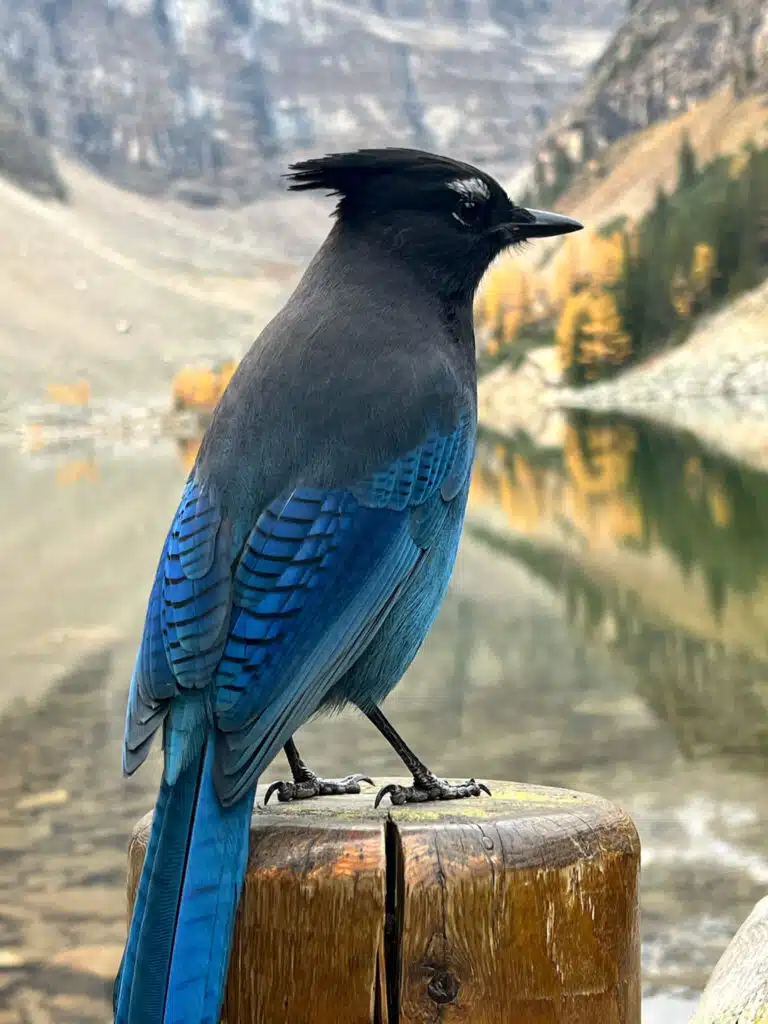
This bird has long legs and a slender bill. The head can vary from black-brown to black, or dark blue with light streaks on the forehead. They are silver-blue from the shoulders and lower breasts. The tail is bright blue with dark bars.
You are likely to find this bird in forest areas.
Distribution: Alaska, western United States, western Canada, western Mexico, Nicaragua
Migratory: Partially, sometimes moving to lower elevations during the winter months.
2. Common Grackle
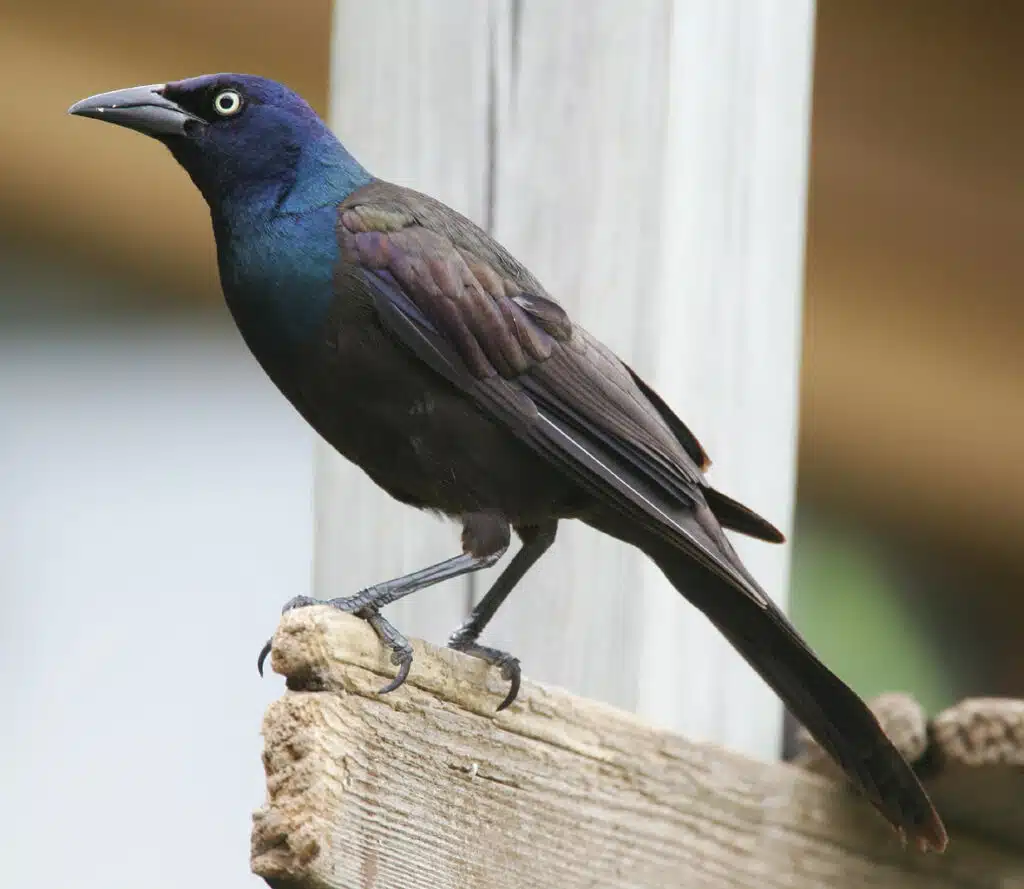
The Common Grackle (Quiscalus quiscula) is a large icterid bird, often found in large numbers. These birds were first described in 1758. As adults, they have dark bills with pale yellow eyes. This bird can grow to 34cm in length with a 46cm wingspan. They can weigh up to 142g.
Males’ average weight is 122g, while females’ average weight is around 94g. The adults have a long bill, long tails with black feathers. They have a tinge of blue, green, or purple iridescence on their heads. As juveniles, they are brown with brown eyes.
They prefer open and semi-open areas, nesting in concealed cups in dense trees and shrubs. They are often close to a freshwater source.
Distribution: North America, east of the Rocky Mountains
Migratory: Yes
3. European Starling
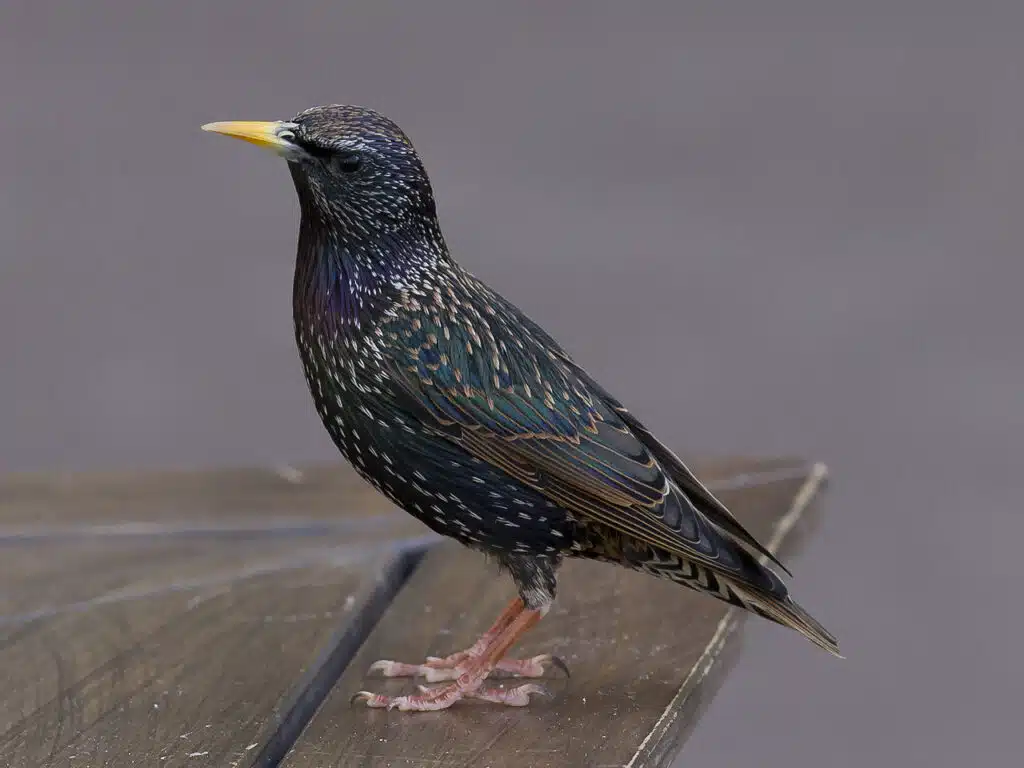
European Starlings (Sturnus vulgaris) are medium-sized passerine birds that grow to around 20cm in length. They are glossy black with a metallic sheen. They have pink legs with a black bill during winter. The bill turns yellow in summer.
Younger birds have brown plumage. They are very noisy and gregarious. In large flocks they are considered beneficial, helping to control invertebrate pests. They can be a pest bird when feeding on sprouting crops and fruits.
Distribution: Europe, Asia, Africa, North America, New Zealand, Australia, Central America, Bahamas, Yucatan Peninsula, Jamaica, Puerto Rico, and Cuba.
Migratory: no
4. Tree Swallow
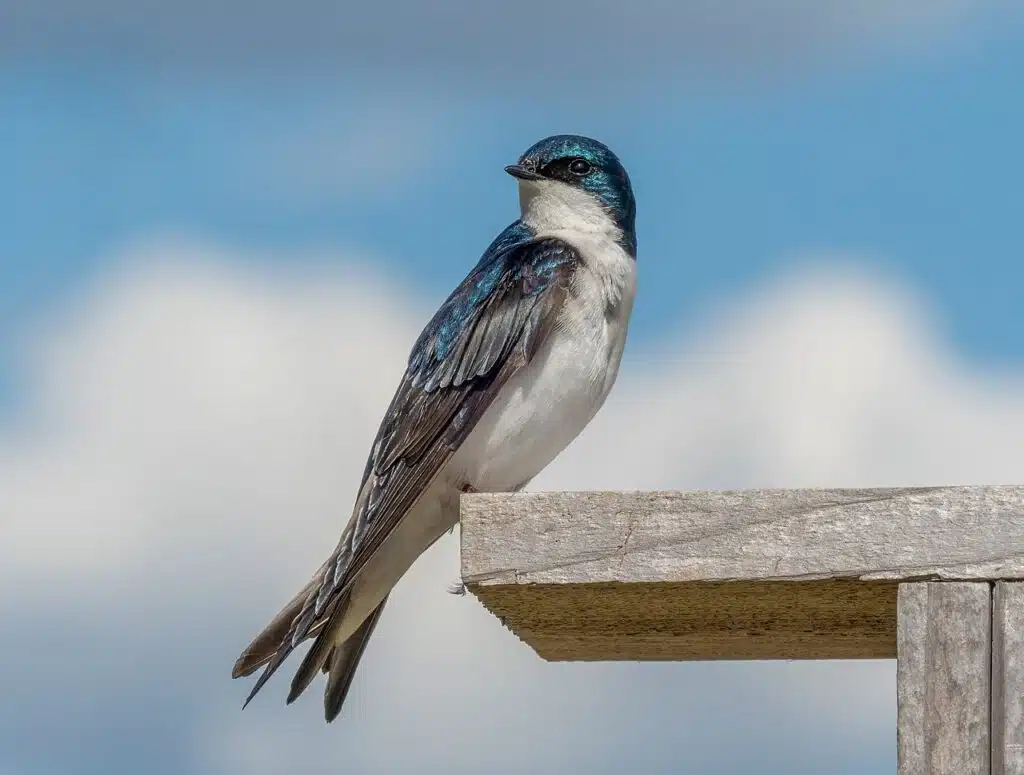
The Tree Swallow (Tachycineta bicolor) was first described in 1807. This bird is glossy green-blue with black wings and tails. It is white on the belly. They have black bills, dark brown eyes, and pale brown legs and feet.
The males are brighter than the females. As juveniles, they are brown with gray-brown washed breasts. They are often seen as pairs or loose groups in natural and artificial cavities.
They forage in groups or on their own, feeding on insects, spiders, and fruits. This bird can grow to 14cm, weighing up to 25.5g. Their wingspan is approximately 35cm. They prefer open and wooded areas close to a water source.
Distribution: Most of North America in summer. In winter, they range from the southern coastline of the United States to Central America and Mexico.
Migratory: Yes
5. Indigo Bunting
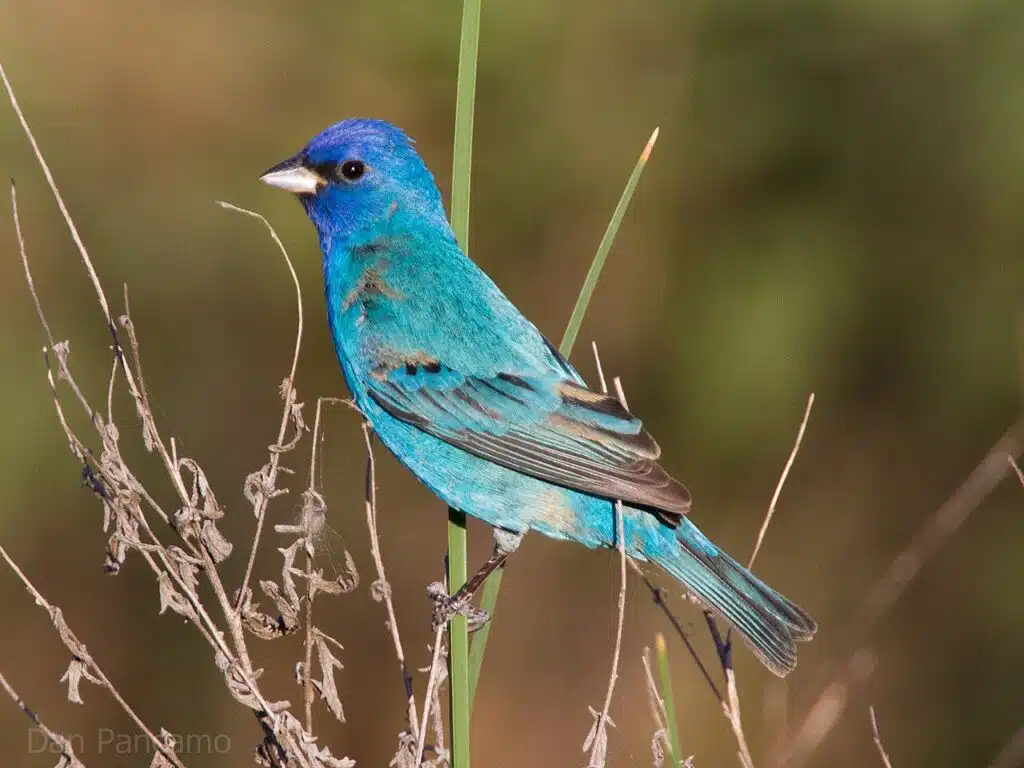
This is a seed-eating bird that belongs to the cardinal family. They (Passerina cyanea) are small birds that are often seen in farmlands, open woodlands, and brush areas. This bird can grow to 13cm in length.
The males are bright blue in summer with bright plumage during the breeding season. They are brown during winter. Females tend to be brown throughout the year. They only weigh an average of 14.5g with a wingspan of 23cm.
During the breeding season, the males are bright blue with an indigo head. Their tails and wings are black with blue edges. There has been an increase in the Indigo Bunting populations in forest clearings and farmland development.
Distribution: Great Plains, Utah, Arizona, and California.
Migratory: yes
6. Purple Martin
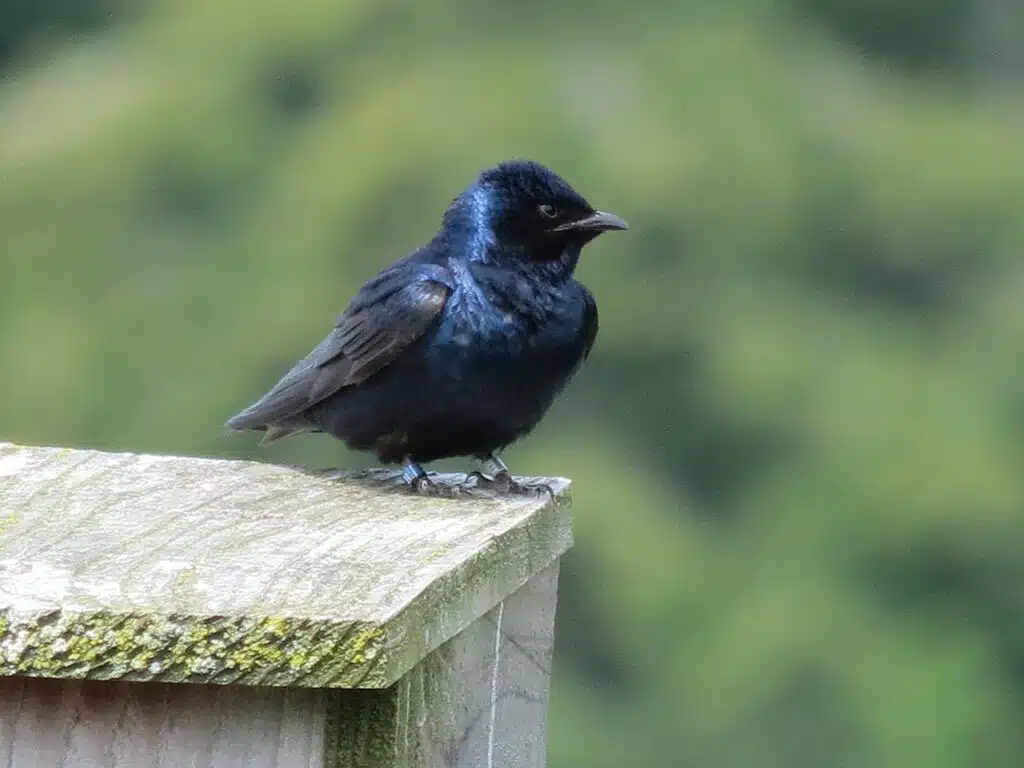
The Purple Martin (Progne subis) belongs to the Swallow family. It is the largest swallow in North America. It has dark black-blue feathers with an iridescent sheen. The majority of these birds have a bright blue or navy blue appearance, others tend to be purple or green.
These are fast and agile flyers using a rapid flapping and then gliding flight pattern. They grow to 20cm in length with a 38cm wingspan. They weigh approximately 60g.
They are vocal birds known to rattle, croak, and chirp. They are often located close to humans, even in towns and cities.
Distribution: Throughout North America, spending the non-breeding season in South America, mainly Brazil.
Migratory: Yes
7. Blue Jay
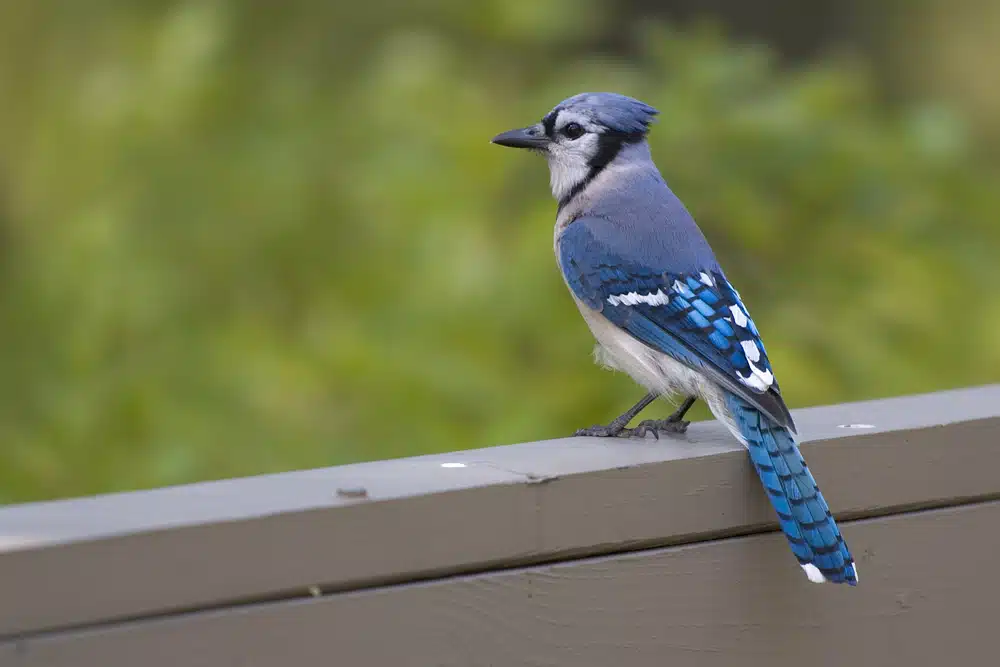
The Blue Jay (Cyanocitta cristata) is a passerine bird that prefers deciduous and coniferous forests, along with residential areas. These birds are predominantly blue with white chests and bellies. They have a blue crest.
They have a distinct U-shaped collar in black around the neck and a black border just behind the crest. Their diet comprises seeds, nuts, acorns, fruits, small vertebrates, and arthropods. They are aggressive towards other birds, often raiding nests.
They construct an open cup nest in tree branches. This bird grows to 30cm in length, weighing up to 100g. Their wingspan can be up to 43cm. They have crests on the head, which can be raised or lowered based on their mood. The crest is fully raised when they are aggressive or excited. They push the crest outwards when frightened.
The plumage is lavender-blue in the crest, wings, tail, and back. The face is white. Undersides are off-white. They have strong black, blue, and white barring on the wings and tail. Their legs, bill, and eyes are black.
Distribution: Southern Canada, Eastern United States, and Central United States.
Migratory: Yes
8. Blue Grosbeak
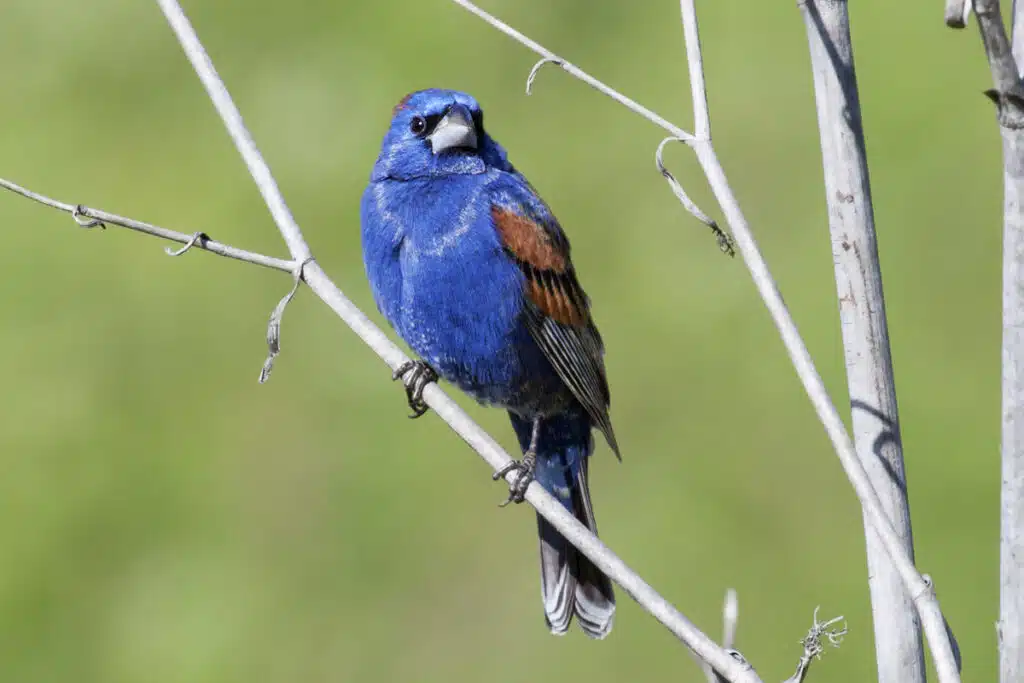
This medium-sized bird (Passerina caerulea) belongs to the cardinal family. The male is blue with brown wing bars. Females are mostly brown with blue feathers on the upper parts and brown wing bars.
The males are deep blue with black and brown on the wings, whereas the females are mostly brown. They can grow to 19cm in length with a 29cm wingspan. They weigh up to 31.5g.
They are often seen in open habitats with scattered trees, scrub, thickets, riparian woodlands, woodland edges, hedgerows, overgrown fields, and cultivated lands.
Distribution: Southern half of the United States, northern Mexico, South America, and Central America.
Migratory: Yes
9. Black-throated Blue Warbler
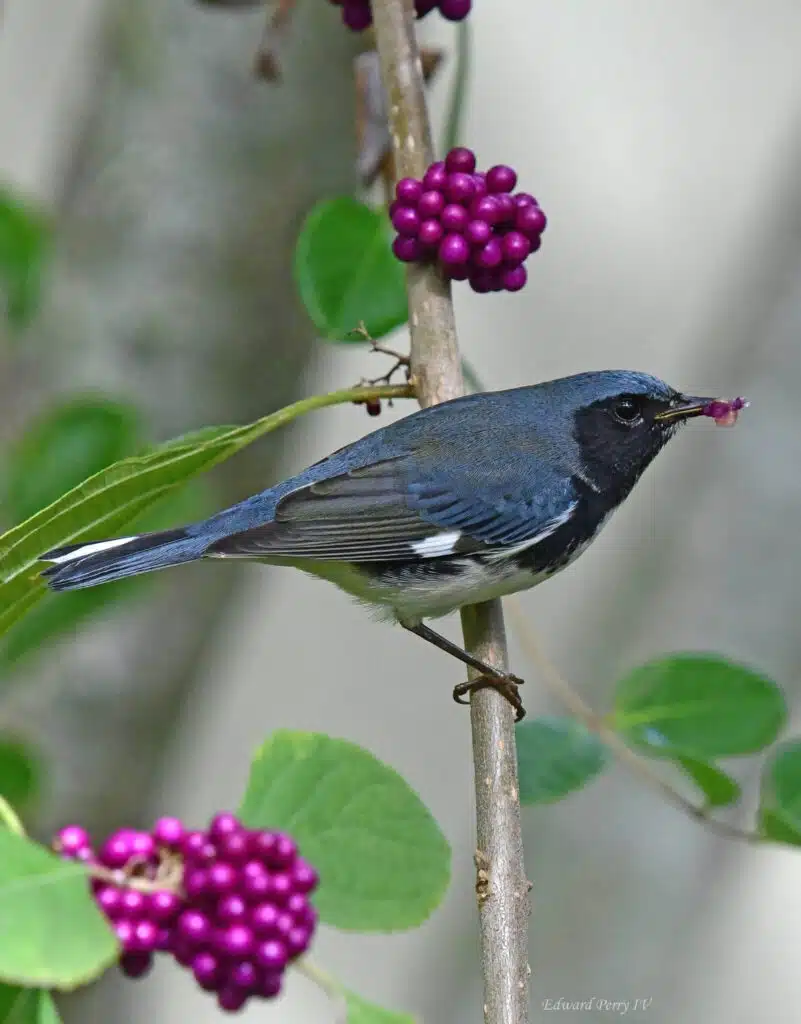
This (Setophaga caerulescens) is a small passerine bird that is found in mixed coniferous forests and deciduous forests. Adult males have black faces and cheeks, deep blue on the top, and white on the belly. Females are olive-brown on their backs and light yellow on the belly.
These birds feed on insects, berries, and seeds. Their nests can be found in thick shrubs, close to the ground. They grow to 13cm in length and 20cm in wingspan, weighing up to 12.4g. They have thin pointed bills and white wing patches, which may not be visible.
Distribution: Northeastern United States, southeastern Canada.
Migratory: Yes
10. Purple Gallinule
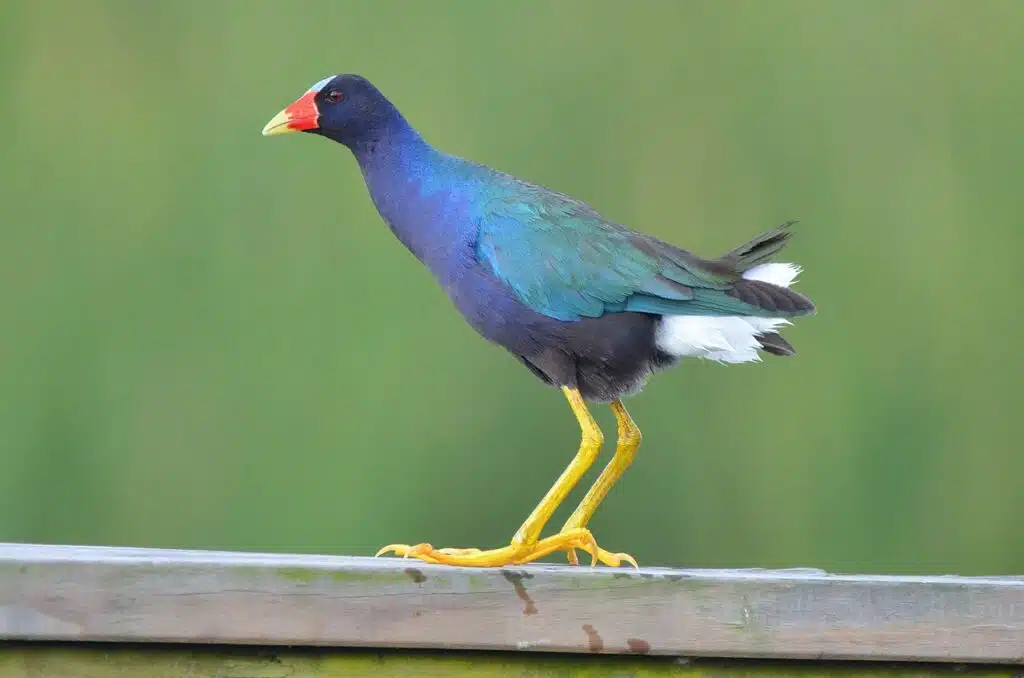
The Purple Gallinule (Porphyrio martinica) is also known as the yellow-legged gallinule. This medium-sized bird can grow to 37cm in length with a 61cm wingspan. They can weigh up to 3.5g. Males are slightly larger than females.
These birds have purple-blue plumage that shines turquoise and green in good lighting. They have a pale blue shield on the forehead, connecting to the red and yellow bill. As juveniles, they are brown-bronze with purple on the chest. The bill and forehead are pale.
These birds have long toes, helping them walk on floating vegetation. As adults, they have bright yellow feet and legs. Juveniles have brown-yellow feet and legs. They hang their legs down during flight.
Distribution: Southern Florida, Gulf coast of Mexico, Pacific coast of Mexico, Central America, and the Caribbean.
Migratory: Yes
11. Yellow-billed Magpie
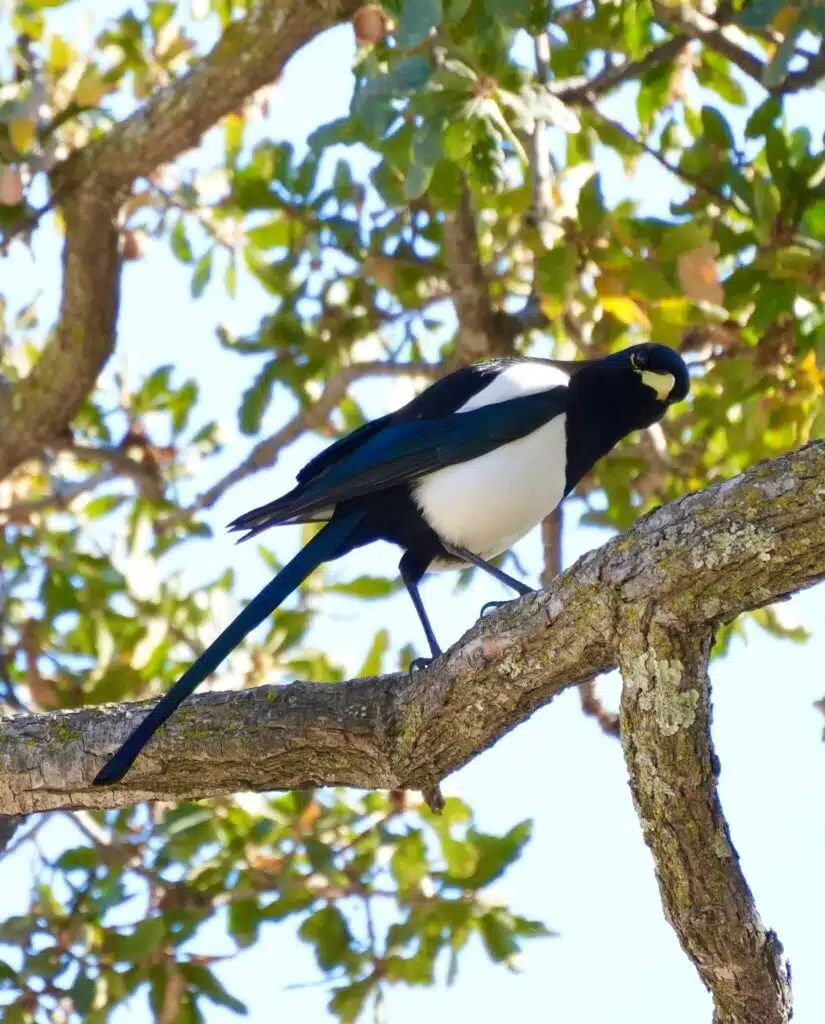
This bird (Pica nuttalli) is also known as the California magpie. It is a large bird with a yellow bill and a yellow streak around the eye. This large black-and-white bird is related to the crow family. It has a long flat tail and bold pattern. There is iridescent blue-green on the tail and wings.
They are often seen in pairs or small groups. They prefer oak woodlands, orchards, and agricultural fields. This bird can grow to 54cm in length with a 61cm wingspan, weighing up to 170g.
Distribution: California
Migratory: No
12. Great Frigatebird
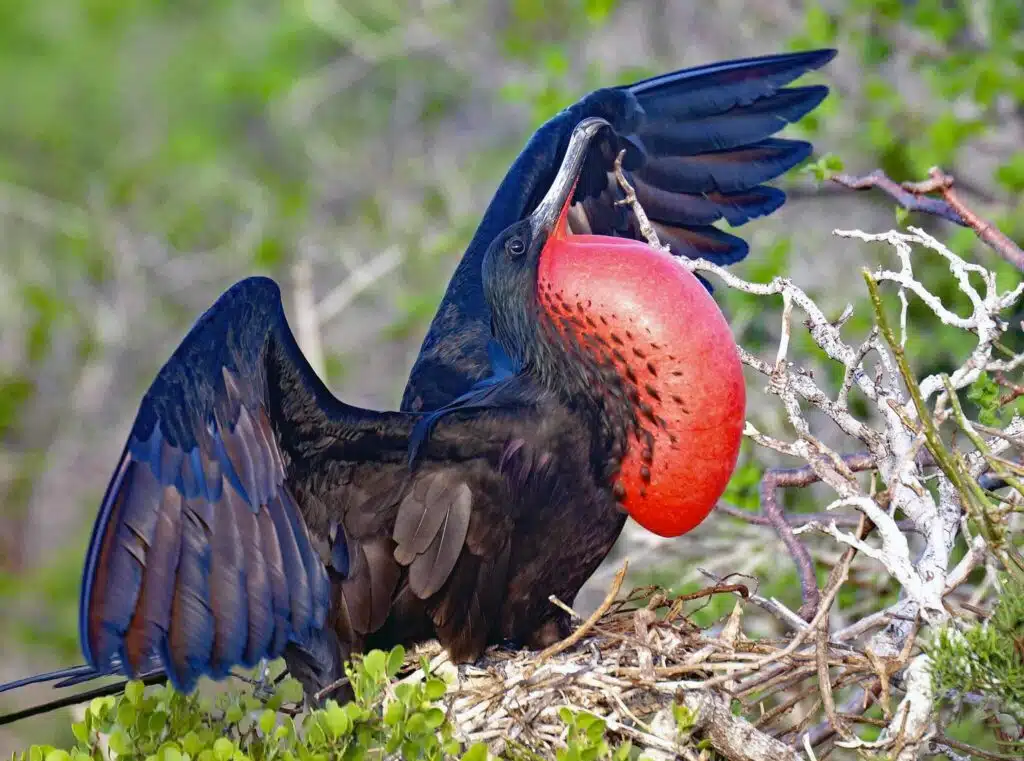
This (Fregata minor) is a large seabird that belongs to the frigate bird family. They are large and can grow to 105cm in length. Their plumage is predominantly black. Females are larger than males.
The males have a purple-green sheen to their feathers. They feed on fish taken from the ocean’s surface. They have a 230cm wingspan with males weighing up to 1,450g and females weighing up to 1,590g.
The wings are narrow and pointed. They have narrow and long tails that are deeply forked.
Distribution: Florida, Caribbean, Cape Verde Islands, Pacific Coast of the Americas, Mexico, Ecuador, Galapagos Islands.
Migratory: Yes
13. Great-tailed Grackle
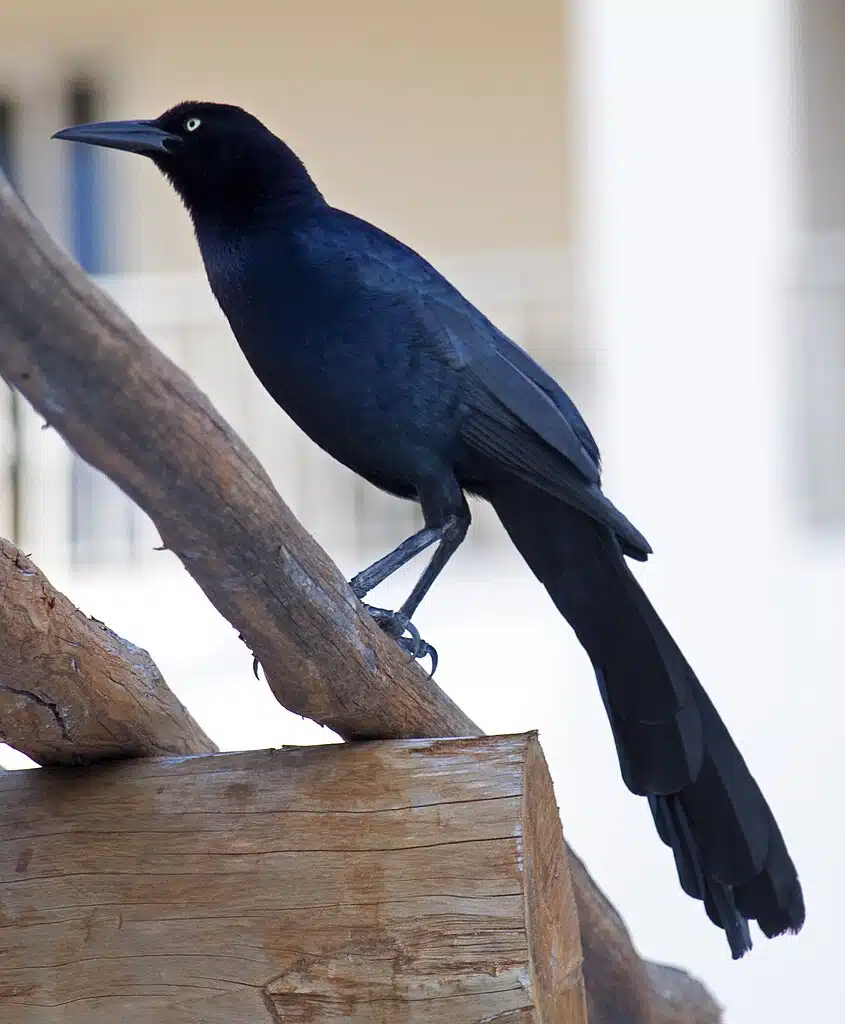
The Great-tailed Grackle (Quiscalus mexicanus) is also known as the Mexican grackle. It is a medium-sized bird. They grow to 38cm in length with males weighing up to 203g and females weighing up to 115g. They have long tails with a wingspan of up to 58cm.
The males are iridescent black with a purple-blue sheen on the head and upper body. Females are brown with dark wings and tails. They have bright yellow eyes. Their tails are keel-shaped, folding vertically.
They forage on the ground in clear areas, including wetlands, mangroves, chaparral, and pastures. They are also found in urban and agricultural settings.
Distribution: Central America, South America, United States, and Canada.
Migratory: Yes
14. Varied Bunting
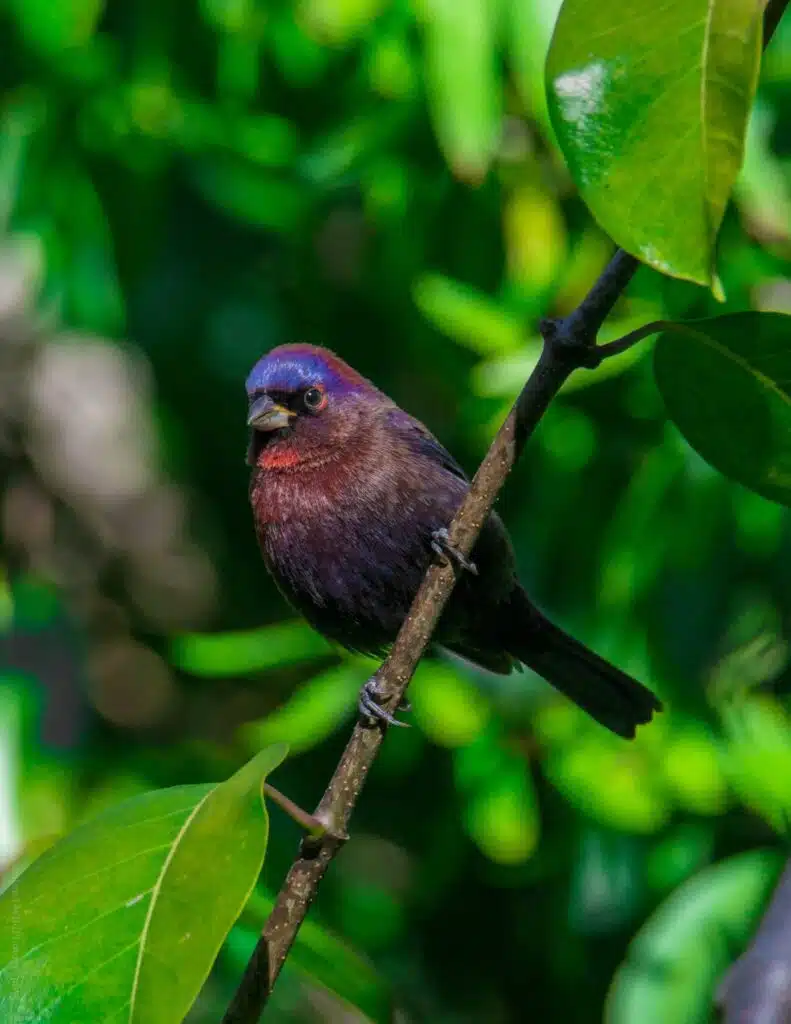
The Varied Bunting (Passerina versicolor) is a songbird in the cardinal family. They are stocky birds with a rounded bill and short tails. They can grow to 14cm in length with a 21cm wingspan. They weigh around 13g.
Breeding males are red-purple with a bright red patch on the nape. The red patch becomes brown in the fall. Females are plain brown. They can be found in shrublands, thickets, thorn forests, deserts, overgrown clearings, and woodlands.
They forage on the ground for seeds, fruit, and insects. They build their cup-shaped nests close to a permanent water source.
Distribution: Mexico, Guatemala, southern Texas, southeast and southwest New Mexico, and southern Arizona.
Migratory: Yes
15. Red-legged Honeycreeper
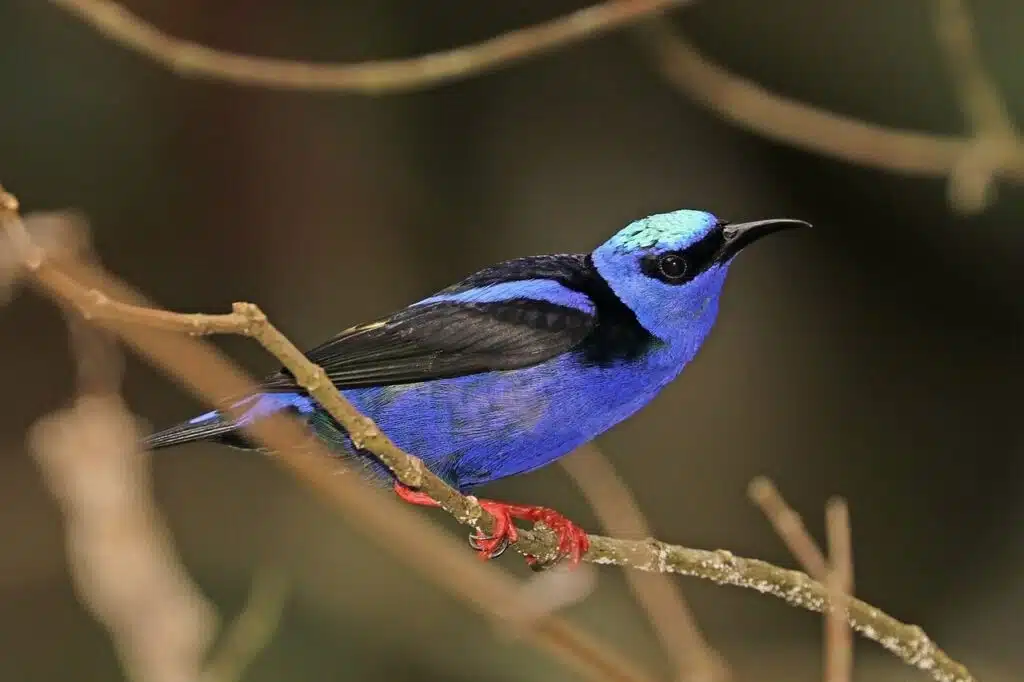
The Red-legged Honeycreeper (Cyanerpes cyaneus) is a small songbird that can grow to 12.2 cm in length. They weigh up to 14g. They have a black bill. The males are violet-blue with black wings, back, and tail. They have bright red legs and a turquoise crown on their heads.
The females and juveniles tend to be green with faint streaks on their belly. The females have brown-red legs and the juveniles have brown legs. They are commonly seen in open woodlands, cocoa and citrus plantations, and forest edges. They are often seen in small groups where they feed on seeds, nectar, and insects.
Distribution: Southern Mexico, Peru, Bolivia, central Brazil, Trinidad and Tobago, Cuba.
Migratory: yes
16. Black-throated Magpie-Jay
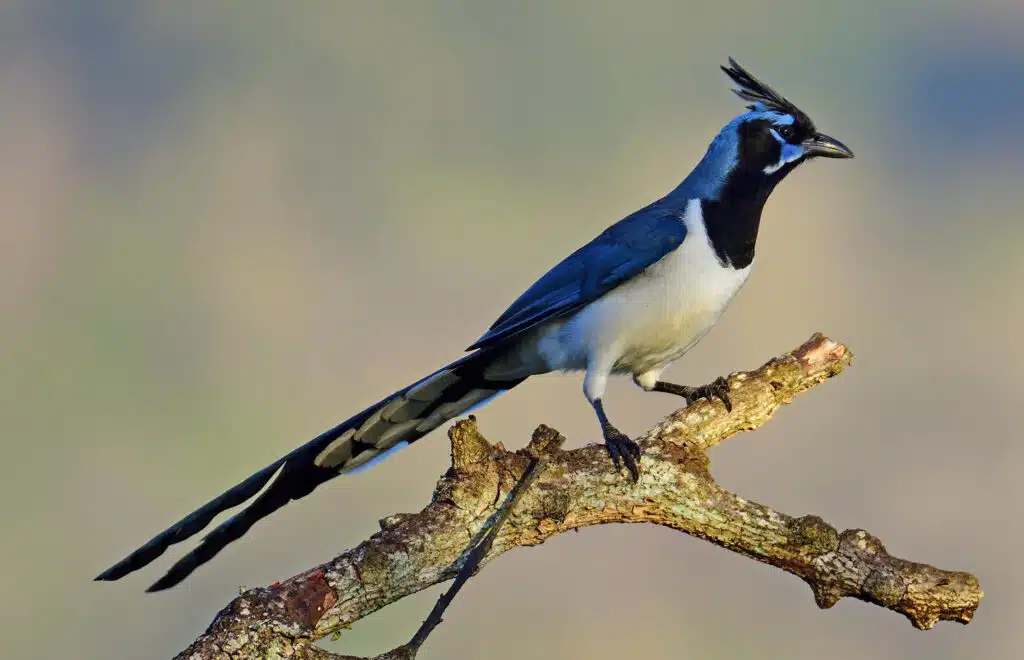
The Black-throated Magpie-Jay (Calocitta colliei) is a large bird growing to 76.5cm in length and weighing up to 251g. They are blue with white tips on the tail feathers. Their bellies are white.
The legs, head, bill, and crest are black with a light blue crescent located just above the eyes. Juveniles have a white tip to their crests and a blue patch under their eyes.
They are commonly seen in small groups in open areas and woodlands.
Distribution: The Pacific Slope of Mexico, southern Sonora, Jalisco, northwestern Colima. They have also established themselves in the Tijuana River Valley in San Diego County and Baja California.
Migratory: No
17. Black-billed Magpie
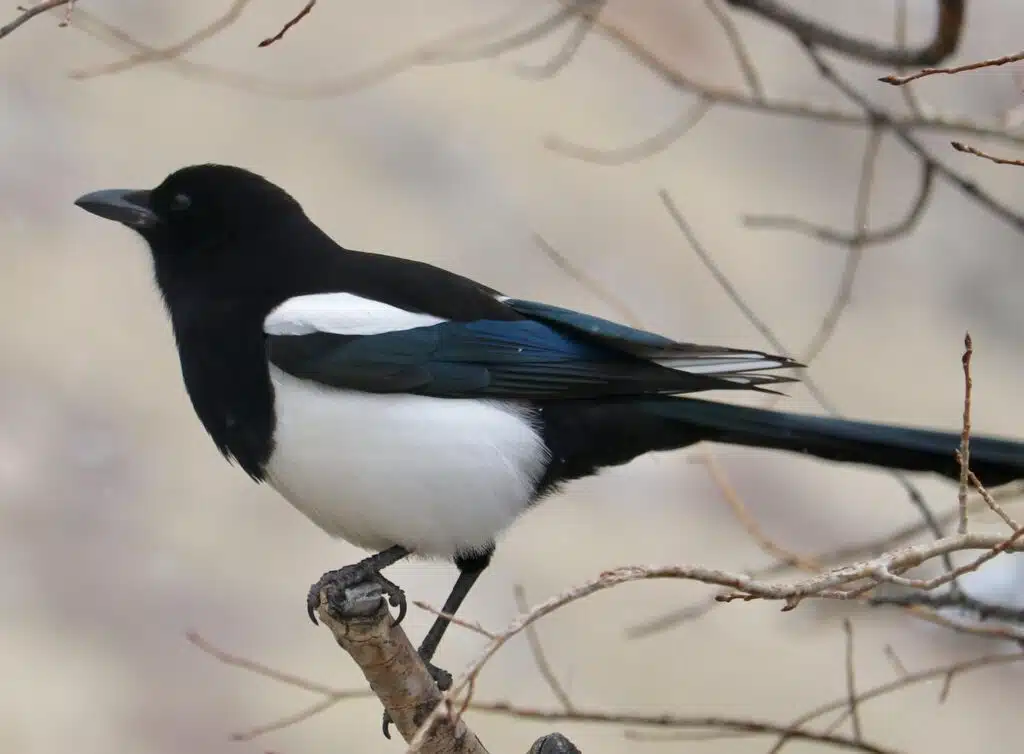
This bird (Pica hudsonia) is also known as the American magpie. It is black and white with black on the wings. The tail has blue or blue-green iridescence. They prefer open habitats with trees. They are common visitors in suburban areas and farmlands, coming into regular contact with humans.
This medium-sized bird can grow to 60cm in length. The tail comprises long feathers with the middle feathers protruding further out. They have an oblong beak, curved at the tip. The males are nine percent larger than the females.
Distribution: Western half on North America
Migratory: No
18. Superb Fairywren
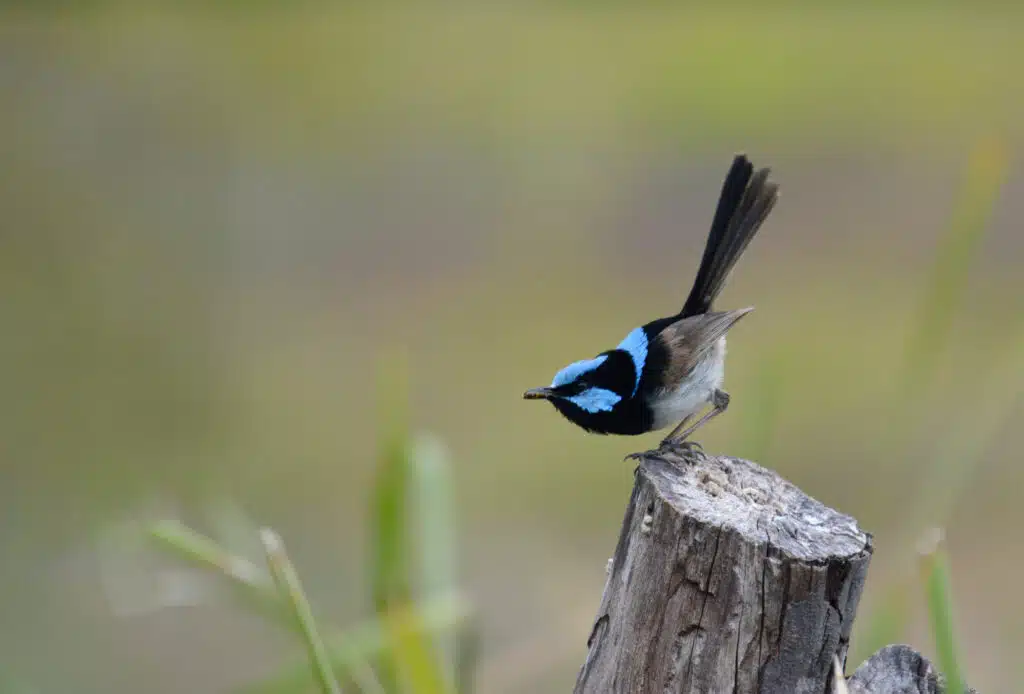
The Superb Fairywren (Malurus cyaneus) is a passerine bird. It is a very territorial species. Males have a bright blue forehead during the breeding season, complete with a black mask and dark blue throat. They are gray-brown out of breeding season. Females and juveniles are gray-brown throughout the year.
They are monogamous birds, forming pairs and assisting with the raising of young. The male will pluck yellow petals and display them to females as a courtship display. They can be found where there is dense undergrowth used for shelter. This includes shrubs, thick forests, heaths, domestic gardens, grasslands, and woodlands.
This bird can grow to 14cm in length and weigh up to 13g. Males are slightly larger than females.
Distribution: Queensland, New South Wales, Victoria, the Eyre Peninsula in Australia.
Migratory: No
19. Oriental Magpie-Robin
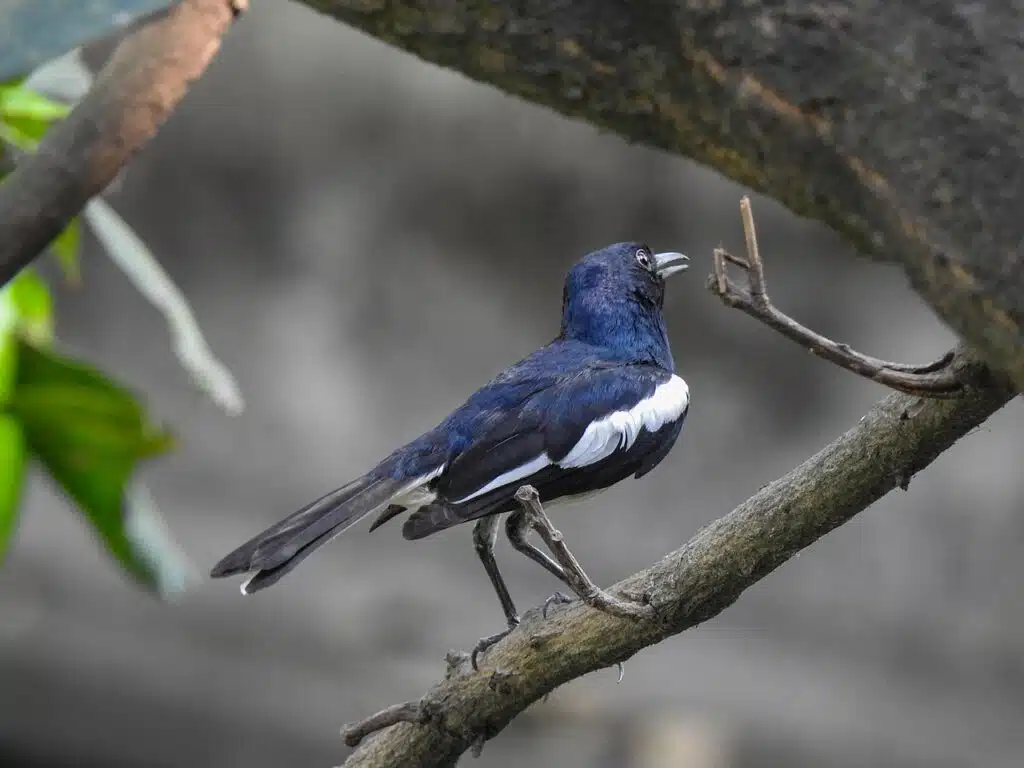
The Oriental Magpie-Robin (Copsychus saularis) is a small bird. They are black and white with long tails. They hold their tails upright when foraging on the ground.
This small bird can grow to 19cm in length, including the tail. The males have black backs, heads, and throats. There is a white shoulder patch. The belly and under the tail are white. Females are gray-black on their backs and gray-white on their belly.
You will find them close to the ground, foraging in leaf litter.
Distribution: Nepal, Bangladesh, India, Sri Lanka, Pakistan, Indonesia, Thailand, China, Singapore, and Malaysia.
Migratory: No
20. Australasian Swamphen
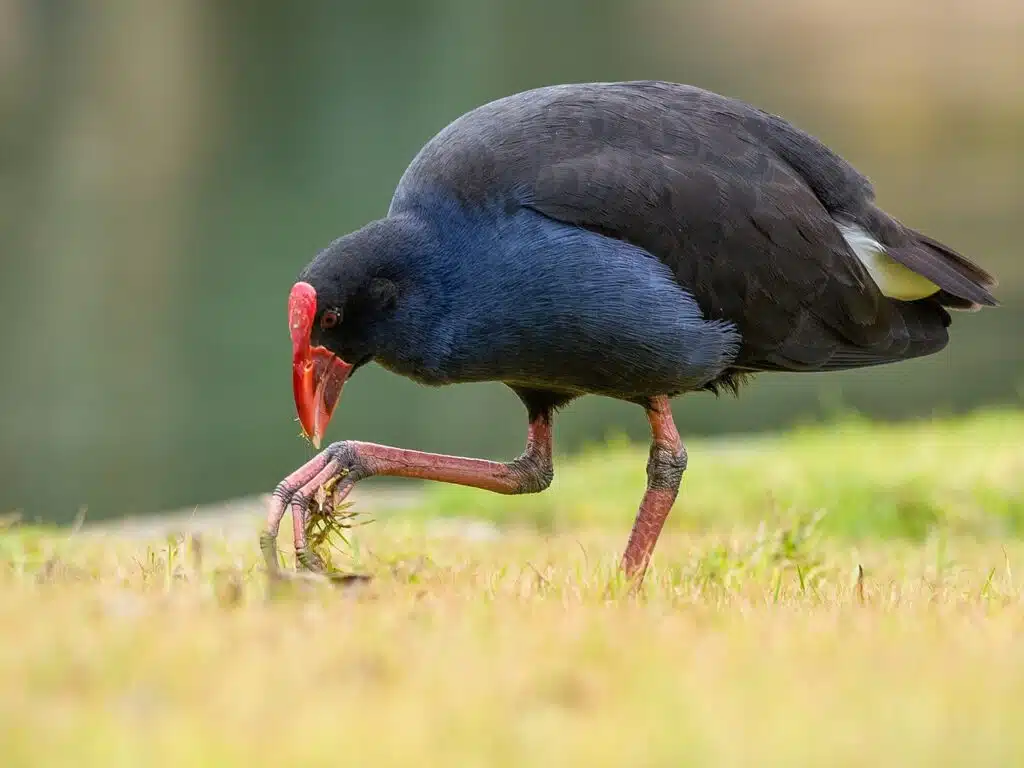
This bird (Porphyrio melanotus) is a swamphen species, also known as the pukeko. They are dusky black on their backs with a dark blue collar. The belly is dark blue to purple. They flick their tails up and down as they work, showing off the underside of the tail that is white.
They have red bills with orange-red feet and legs. They tend to walk away from danger rather than fly. They are clumsy when it comes to taking off and landing with short flight distances.
Distribution: Mainland Australia, eastern Indonesia, Moluccas Islands, Aru Islands, Kai Islands, Papua New Guinea, Main islands of New Zealand,
Migratory: Yes
21. Purple Sunbird
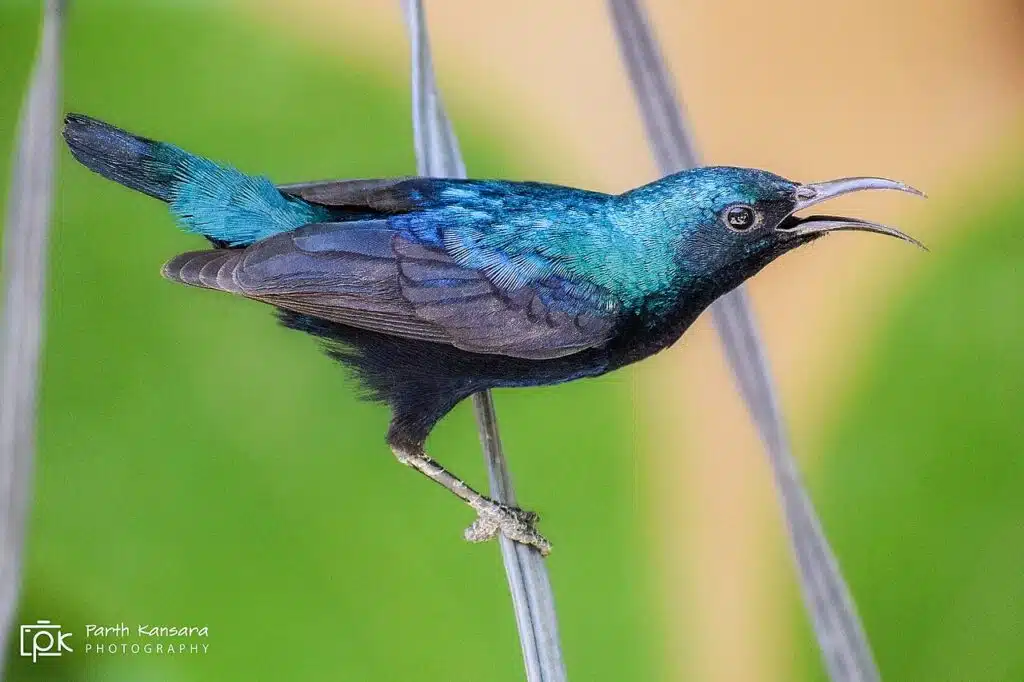
Purple Sunbirds (Cinnyris asiaticus) are small birds that feed on nectar and insects. They are fast flyers and hover like a hummingbird when they feed on nectar. They have short bills and square tails.
These small birds seldom grow to 10cm in length. Males are glossy blue to purple with black backs and dark brown wings. Breeding males have a bright blue patch on the shoulder.
Females are olive-brown with a yellow belly. They have a dark eye stripe. The outer tail feathers have a white tip in both sexes. They are seen in small groups or pairs in gardens. Their diet consists of nectar, fruit, and insects.
Distribution: West Asia, India, Southeast Asia, Pakistan, Sri Lanka, Iran,
Migratory: No
22. Dollarbird
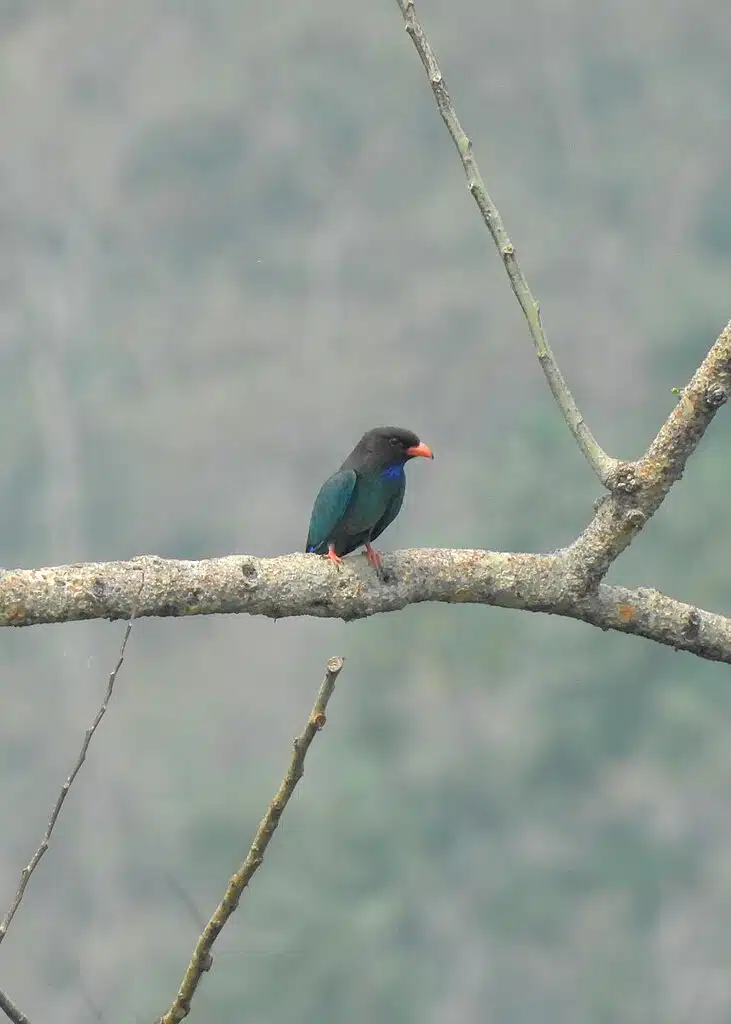
The Dollarbird (Eurystomus orientalis) belongs to the roller family with pale blue or white coin-shaped spots on the wings. This bird can grow to 30cm in length.
They are dark brown with a blue-green sheen on the back and wing covers. The throat is glossy blue, as is under the tail. It has dark blue flight feathers and a short orange-red bill with a black tip. The light blue patches on the wings are visible when it flies.
Females are not as bright as the males. Juveniles are also dull in color without blue on their throats. They can be found in open wooded areas throughout their range.
Distribution: Australia, Japan, India, and New Guinea.
Migratory: Yes
23. Yucatan Jay
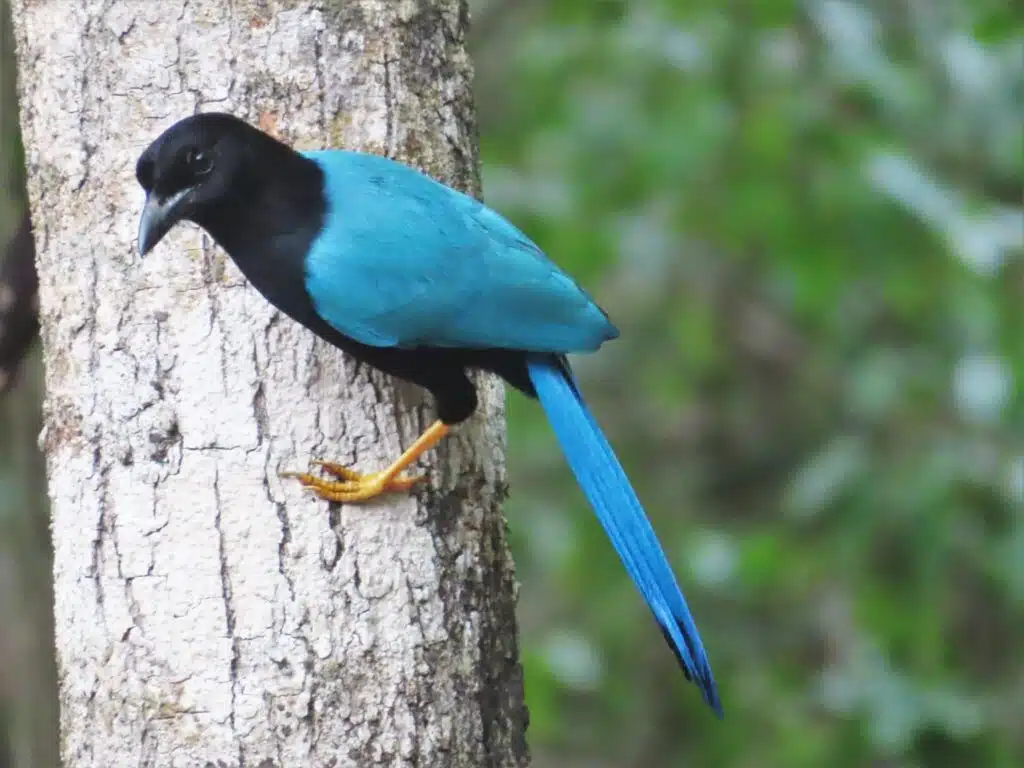
The Yucatan Jay (Cyanocorax yucatanicus) lives in subtropical and tropical dry forests, cleared areas, and plantations. Adults grow to around 30cm in length. They are black with blue wings, tails, and mantle.
These birds have yellow eye rings and legs with black bills. Younger birds have yellow bills.
Distribution: Yucatan Peninsula, including Belize, Guatemala, and Mexican states.
Migratory: No
24. Red-billed Blue-Magpie
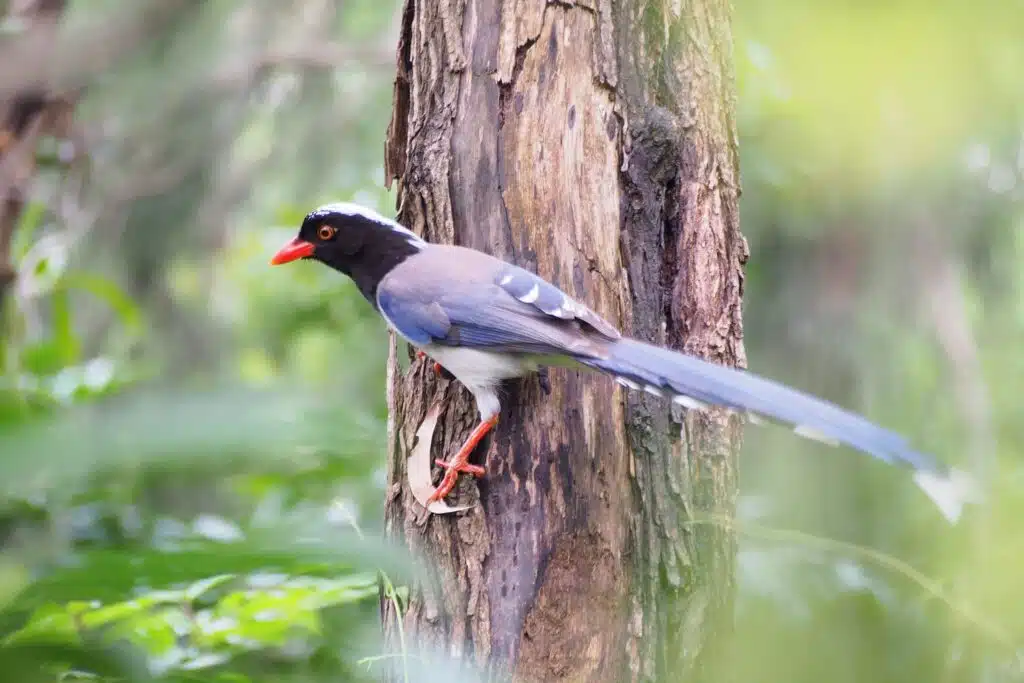
The Red-billed Blue-Magpie (Urocissa erythroryncha) belongs to the crow family. They can grow to 68cm in length and weigh up to 232g. They have long tails.
The neck, breast, and head are black with blue spots on the crown. The rump and shoulders are a dull violet-blue, while the belly is gray-cream. Their long tails are bright violet-blue with a white tip.
They have bright orange-red bills, legs, and feet. There is also a bright orange-red ring around the eyes. They are seen in scrub and evergreen forests, and urban habitats, including large cities. They nest in trees and shrubs.
They forage on the ground and in trees, eating a range of food including small animals, seeds, fruits, and invertebrates. They are known to rob nests of eggs and chicks.
Distribution: Myanmar, Cambodia, Thailand, Laos, Vietnam, China, and Manchuria.
Migratory: Yes
25. Common House Martin
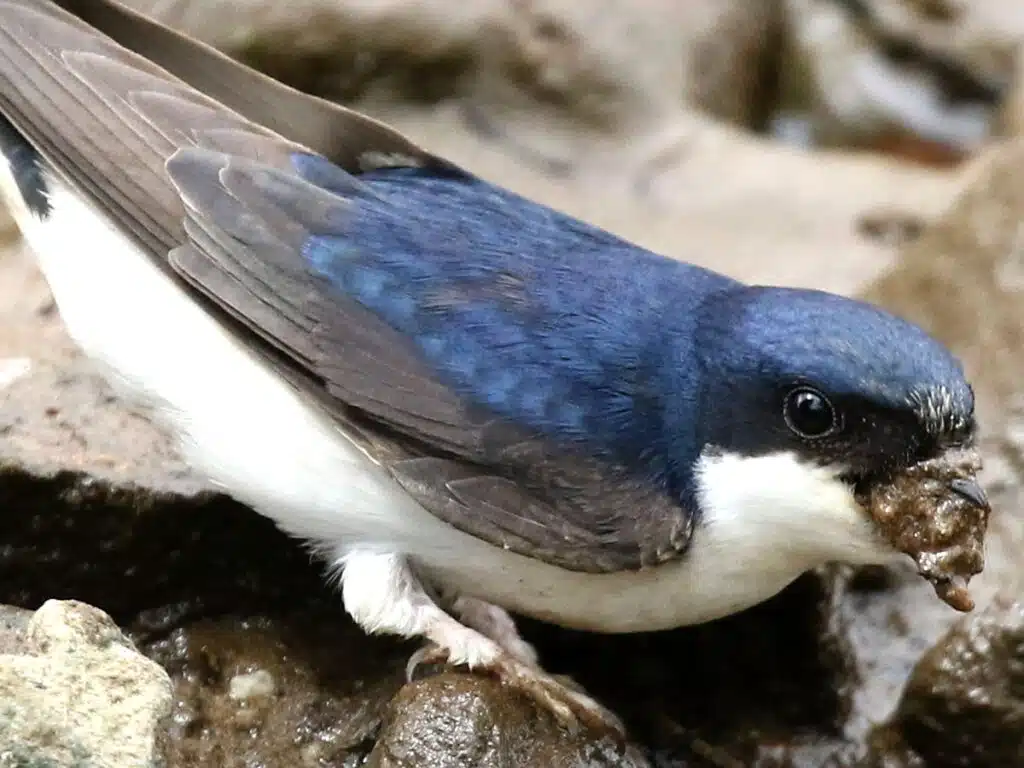
This bird (Delichon urbicum) is sometimes known as the northern house martin and is a passerine bird, belonging to the swallow family. Their diet comprises insects that they catch in flight.
These birds have blue heads and back with white rumps and bellies. They are commonly seen in open country and human habitats. They grow to around 13cm in length with a 29cm wingspan. They can weigh up to 18.3g.
They have brown eyes and small black bills. The toes and exposed leg parts are pink. Juveniles are black with white tips on the quills. They are fast flyers with a wing beat of 4.4 beats per second. They are noisy birds, especially during the breeding season.
You may see them in pastures, farmlands, and meadows. They prefer being close to a permanent water source.
Distribution: Eurosiberia, central Mongolia, Yenisei River, Morocco, Tunisia, Algeria, and Saharan Africa.
Migratory: Yes
26. Tui
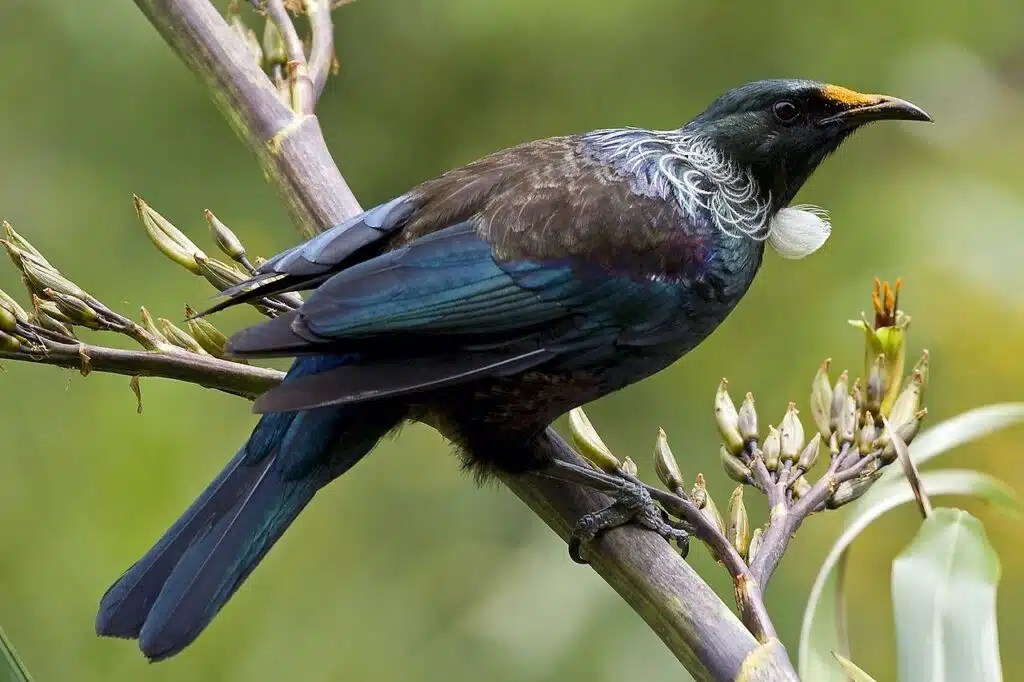
This (Prosthemadera novaeseelandiae) is a medium-sized bird that is blue, green, and bronze with a white throat tuft. It is a boisterous bird, belonging to the passerine bird family.
This bird can grow to 32cm in length and weigh up to 240g. Males are heavier than females. At a glance, it appears black except for the white feathers on the neck and wing. When you look closely you will see brown feathers on the black and an iridescent sheen when in the light.
They prefer broadleaf forests at low altitudes, though they will tolerate exotic plantations and well-vegetated suburbs. They are often seen in pairs or on their own.
Distribution: New Zealand
Migratory: Partially
27. Blue Rock-Thrush
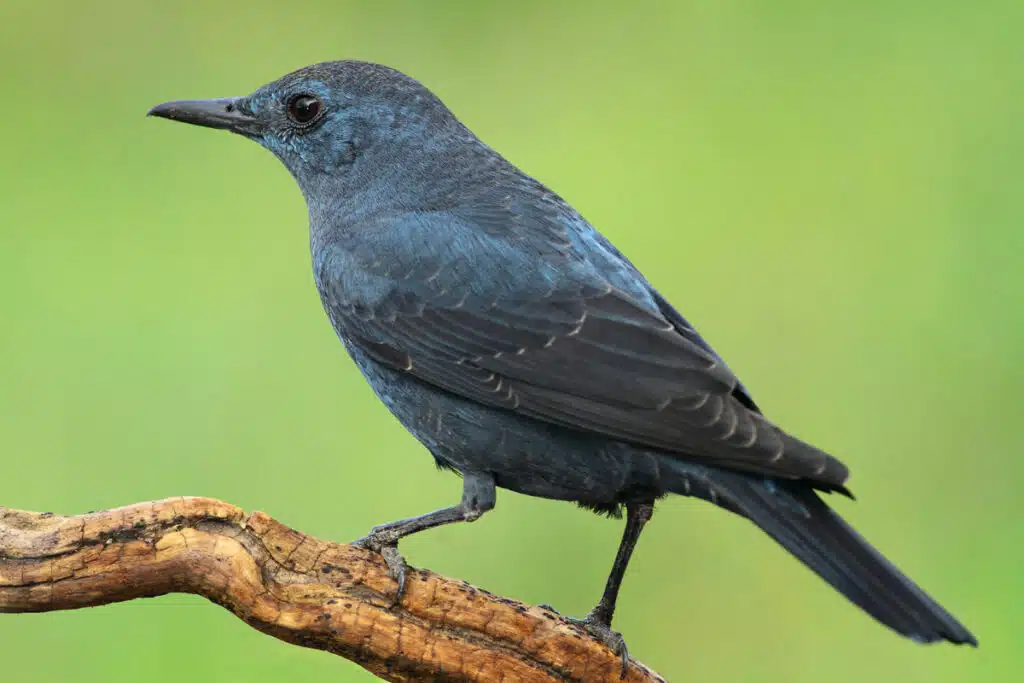
This bird (Monticola solitarius) is a chat species and is the national bird of Malta. They grow to 23cm in length with a long bill. During the breeding season, the male has blue-gray plumage, except for the dark wings.
Females and juveniles are dark brown with a pale brown belly. The males sing a melodious call.
Distribution: Southern Europe, Asia, and Africa. Atlantic Coast and Pacific Islands.
Migratory: Yes
28. Green Honeycreeper
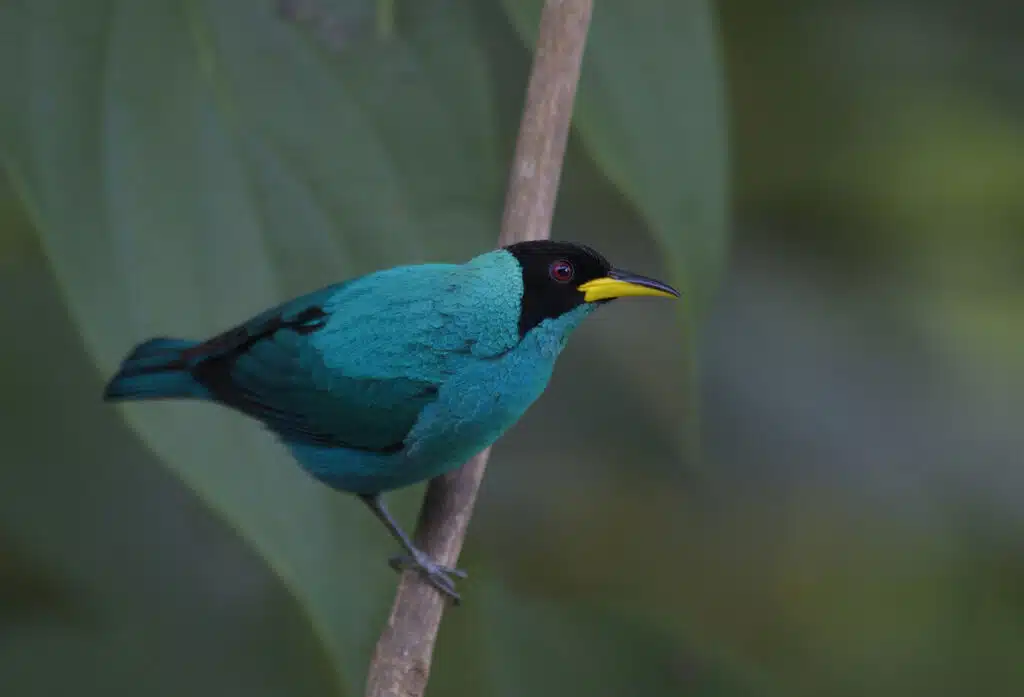
The Green Honeycreeper (Chlorophanes spiza) is a small bird that can grow to 14cm in length with a weight of 23g. They have long decurved bills.
Males are blue-green with black heads and a bright yellow bill. Females are grass green with pale throats and black heads. Juveniles are similar to females.
Distribution: Southern Mexico, Brazil, and Trinidad.
Migratory: No
29. Purplish-backed Jay
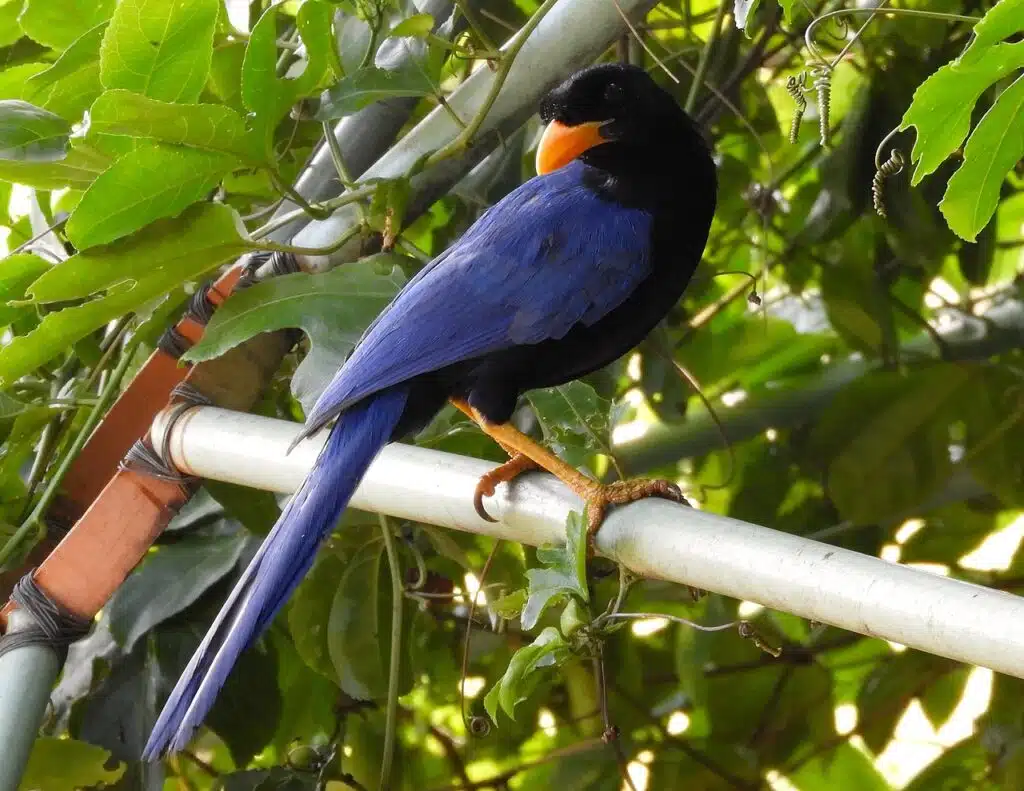
The Purplish-backed Jay (Cyanocorax beecheii) belongs to the crow family. They have purple feathers on their backs, tail, and wings. The rest of the body is black. They are seen in deciduous forests.
They have powerful bills and long tails. They can grow to 41cm in length. Males are larger than females. The neck, head, mantle, and upper parts of the bird are black with a crest on the forehead. Under the wings and tail are black. The rest of the bird is purple-blue. It tends to be brighter on the ramp and lower part of the mantle.
They have a black bill and yellow legs and irises. The population of these birds is declining due to the degradation of dry deciduous forests.
Distribution: Northwest Mexico
Migratory: No
30. San Blas Jay
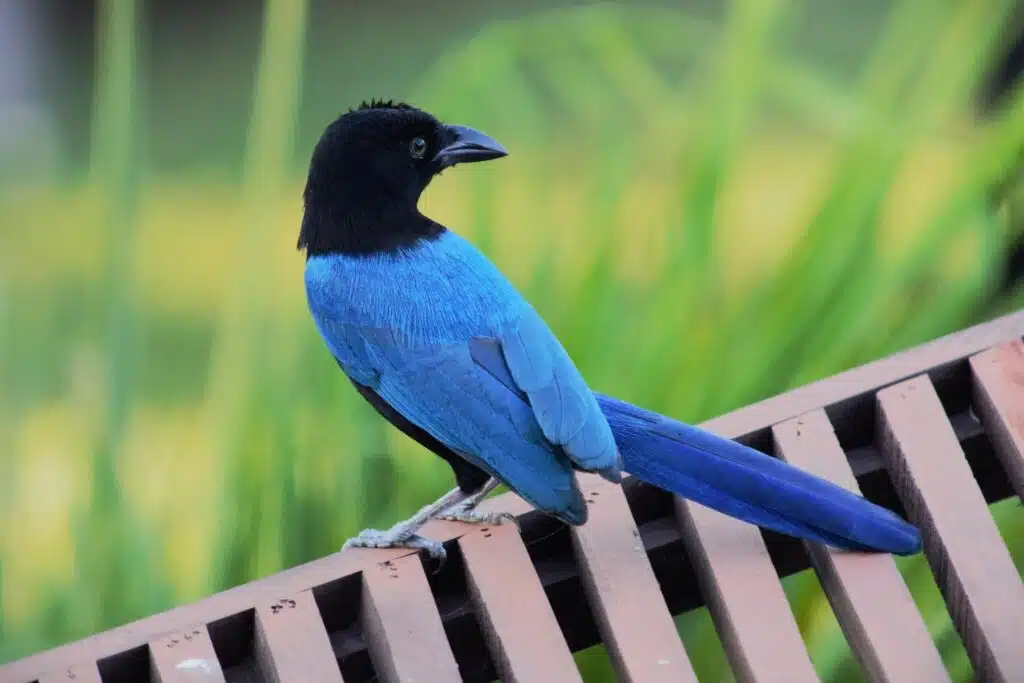
The San Blas Jay (Cyanocorax sanblasianus) is found in natural habitats, such as tropical dry forests and subtropical dry forests.
This bird can grow to 35cm in length and weigh up to 122g. The sexes are similar with wings, tail, rump, and back being blue and the rest of the bird being black.
They have a small crest on their heads and black bills. They have white irises and black legs. They can be found in dry and semi-moist woodlands, groves, plantations, and thickets, along with mangrove areas.
Distribution: Mexico
Migratory: No
31. Long-tailed Manakin
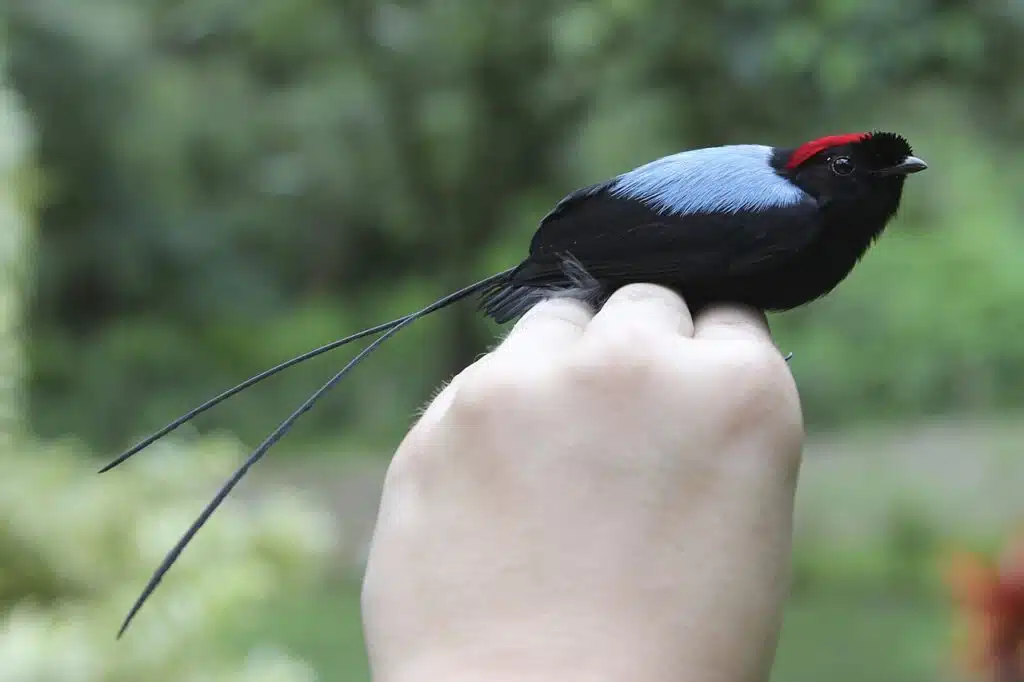
The Long-tailed Manakin (Chiroxiphia linearis) lives in wet and dry tropical and subtropical forests. These are small birds that grow to 10cm in length.
Males are black with blue-black and red crowns. They have elongated central tail feathers. Females and juveniles are olive-green and lighter on their bellies. They can weigh up to 18g.
The males are rich black with bright red legs and crowns and blue backs. They prefer subtropical and tropical dry forests, moist lowland forests, and heavily degraded forest areas.
Distribution: Costa Rica, El Salvador, Honduras, Guatemala, Mexico, and Nicaragua.
Migratory: No
32. Blue Dacnis
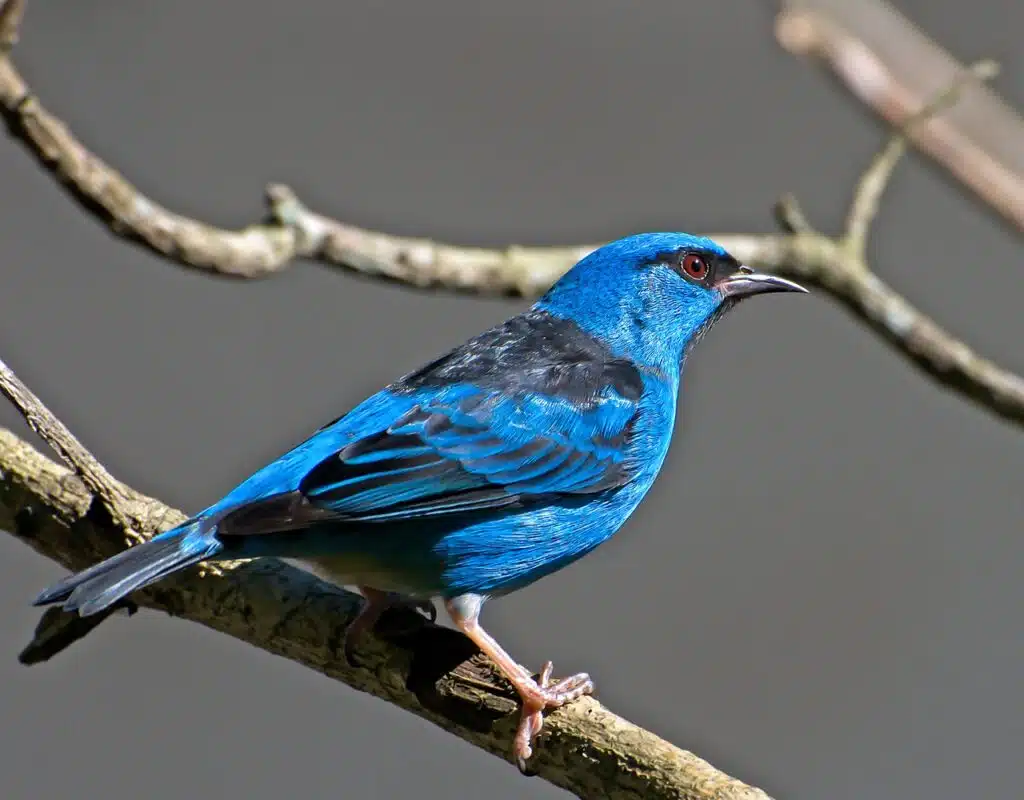
This small passerine bird (Dacnis cayana) can grow to 12.7cm in length and weigh only around 13g. Adult males are turquoise blue with black around their eyes, backs, and throats. The wings and tails are black with turquoise edges.
Females and juveniles are green with blue heads, light green bellies, and green edges on their brown wings. They are common in woodlands, parks, gardens, and forests.
Distribution: Nicaragua, Panama, Trinidad, Bolivia, and northern Argentina
Migratory: No
33. Slaty-breasted Wood-Rail
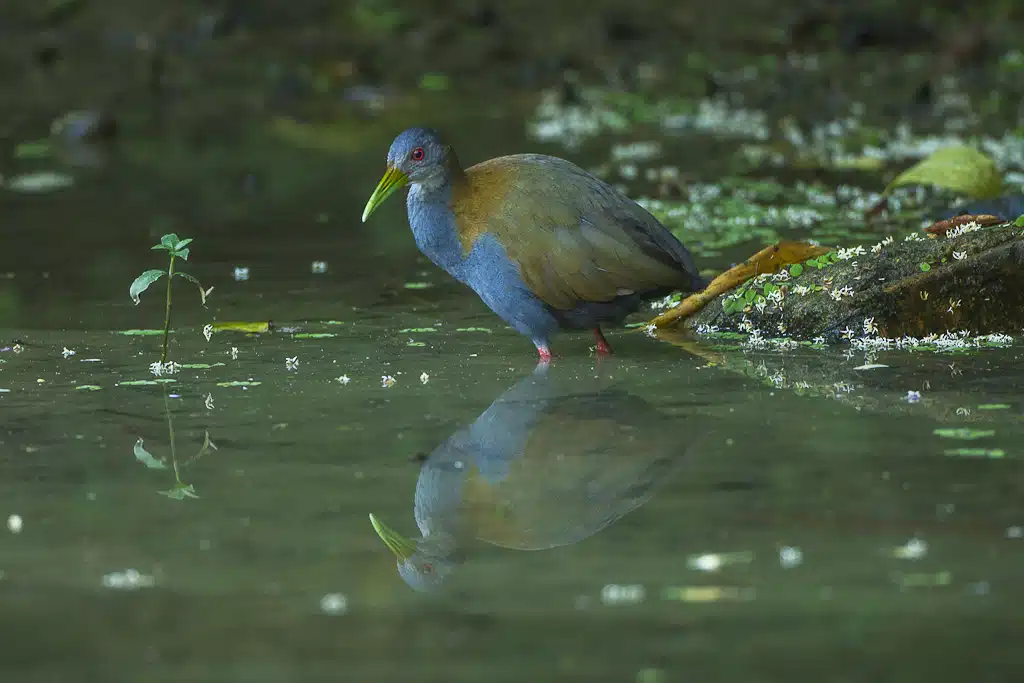
The Slaty-breasted Wood-Rail (Aramides saracura) belongs to the coot family. It can grow to 37cm in length and weigh up to 540g. Males and females are very similar in appearance.
They have a green bill, red eyes, and yellow-brown legs and feet. The head, throat, breast, and belly are gray. The shoulders and nape are chestnut. They have olive backs and black tails.
They are found in wet forests, woodlands, swamp areas, and along streams.
Distribution: Argentina, Brazil, and Paraguay.
Migratory: No
34. Plush-crested Jay
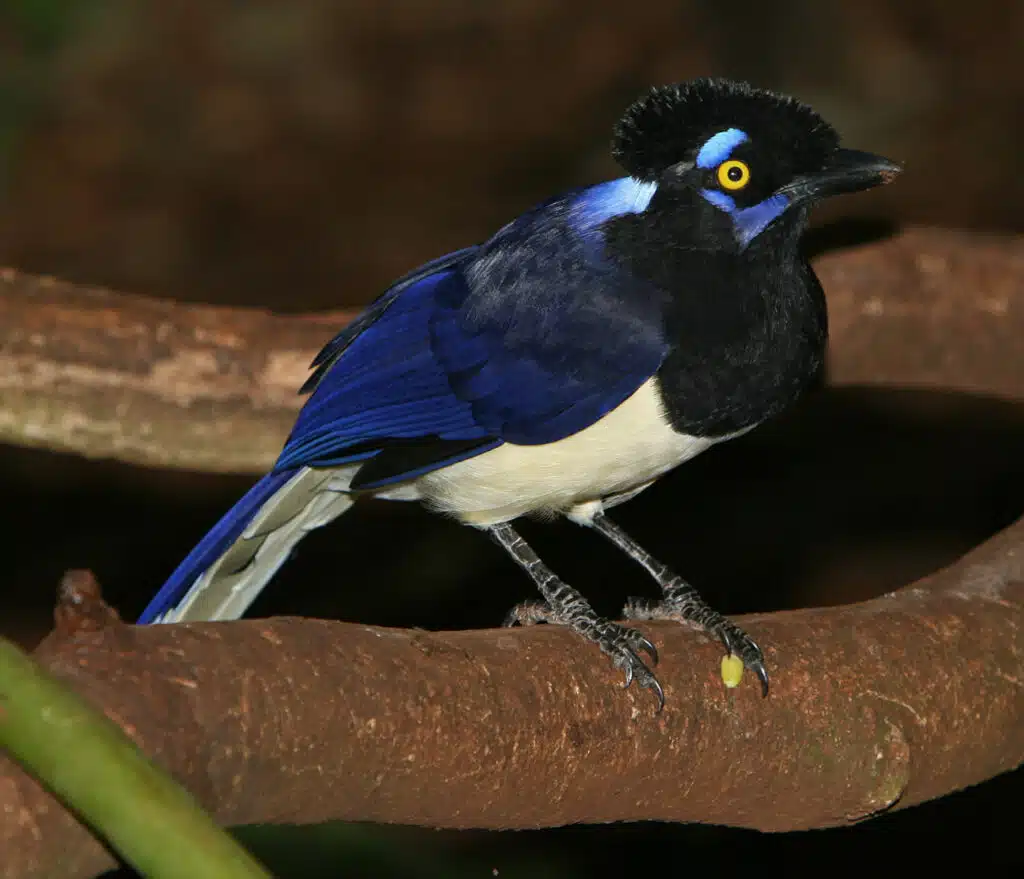
The Plush-crested Jay (Cyanocorax chrysops) is a medium-sized bird that is dark with a yellow-cream breast. They are very elegant birds with cream tails, backs, and bellies.
Their wingspan is 165mm and they can weigh up to 140g. They are dark violet-blue on their backs with black bills and yellow bellies.
They have a crest of crown feathers. Juveniles do not have eye spots. They are similar to adults, but not as bright. These birds have strong legs and are robust in build.
Distribution: central-southern South America, Brazil, Paraguay, Bolivia, Argentina, Uruguay, and southern regions of the Amazon Basin.
Migratory: No
35. Swallow Tanager
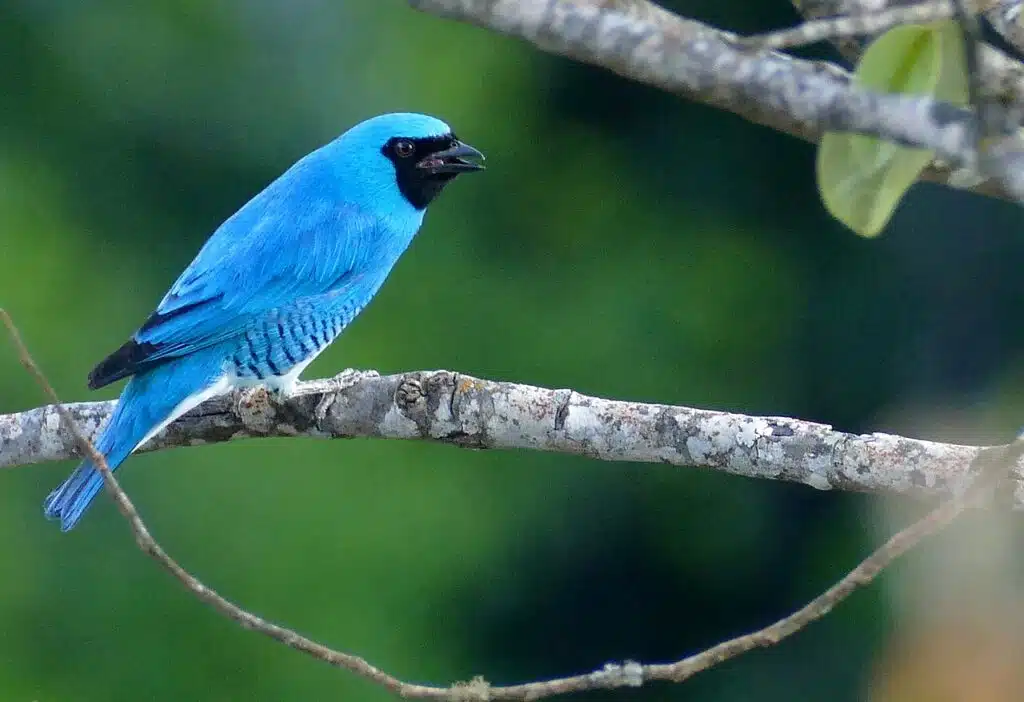
The Swallow Tanager (Tersina viridis) is sexually dimorphism. Females are yellow-green and the males are turquoise blue with a black face and throat patch.
These birds are small, growing to 15cm in length. They have flat broad bills. This bird is highly gregarious, mainly eating fruit and insects.
Distribution: South America, including Brazil.
Migratory: Yes
36. Swallow-tailed Manakin
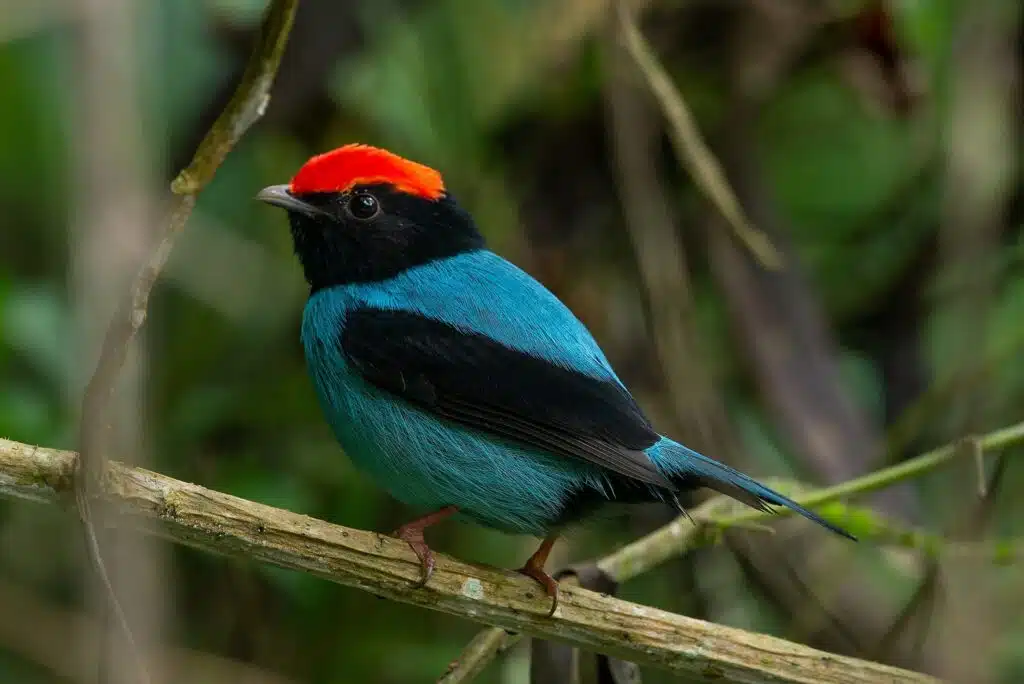
The Swallow-tailed Manakin (Chiroxiphia caudata) is a small bird found in wet lowland or montane forests. The males are bright blue with black heads, wings, and tails, combined with a red crown. Females and juveniles are olive-green.
They can grow to 15cm in length and weigh up to 25.6g. It is a small bird with the male being the manakin with the most blue in its plumage. The entire body of the male is bright blue with a red cap.
Juvenile males look similar to females and over time they develop a red crown, followed by the black face-sides and then the plumage of the adult male.
Distribution: Atlantic forests of south, eastern Brazil, Paraguay, and Argentina.
Migratory: No
37. Woodland Kingfisher
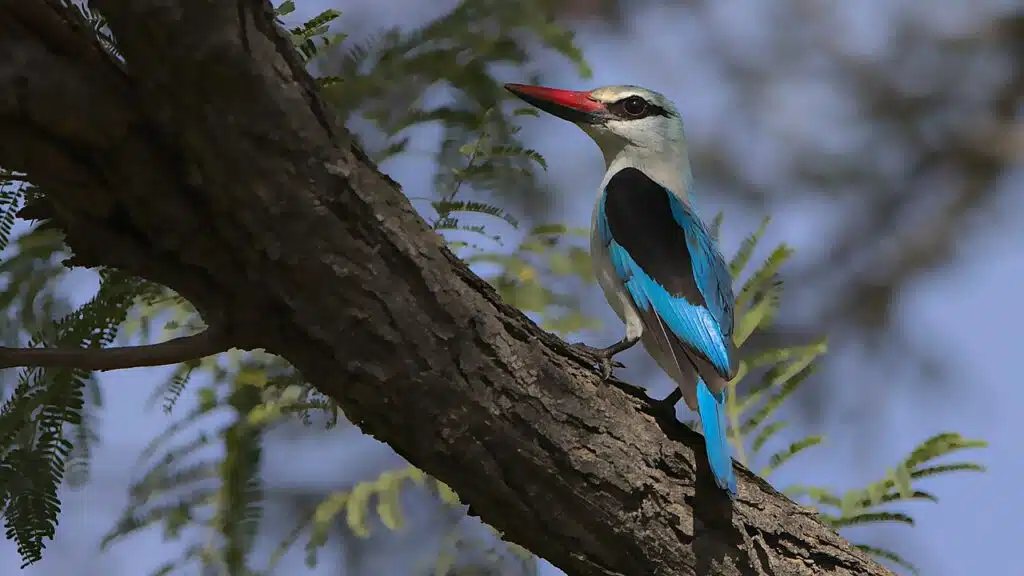
Woodland Kingfishers (Halcyon senegalensis) are medium-sized birds, growing to 23cm in length. Adults are bright blue on their backs, tails, and wing panels. The neck, belly, and head are white with black shoulders.
They have a large bill that is red on the upper mandible and black on the lower mandible. They are fast flyers with gray feet and legs. They have a white wing bar. The sexes are very similar, yet juveniles tend to be dull in color with a brown bill.
They are common in human areas and wooded habitats. They prefer dry habitats, including traditional woodlands close to a permanent water source. They are solitary, though you may see them in a small group.
Distribution: South of the Sahara in Africa.
Migratory: Yes
38. Shining Honeycreeper
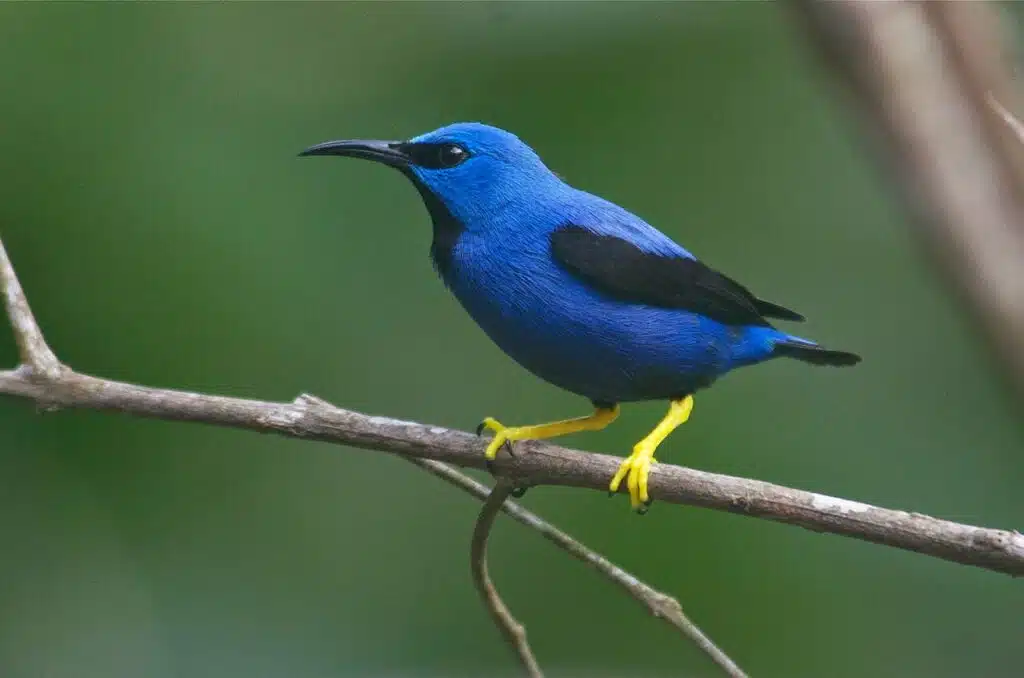
The Shining Honeycreeper (Cyanerpes lucidus) is a small bird found in forest edges. They build cup nests in trees. This bird can grow to 10cm in length and weigh up to 11g. They have long-decurved black bills.
Males are purple-blue with black wings, throats, and tails. The legs are bright yellow. Females are green on their upper parts, with a green-blue head, throat, and underparts. Juveniles are similar to females but are green on the breast and head.
They are often seen in pairs or family groups. They feed on berries, insects, and nectar.
Distribution: Southeastern Mexico to northwestern Columbia.
Migratory: No
39. Vulturine Guineafowl
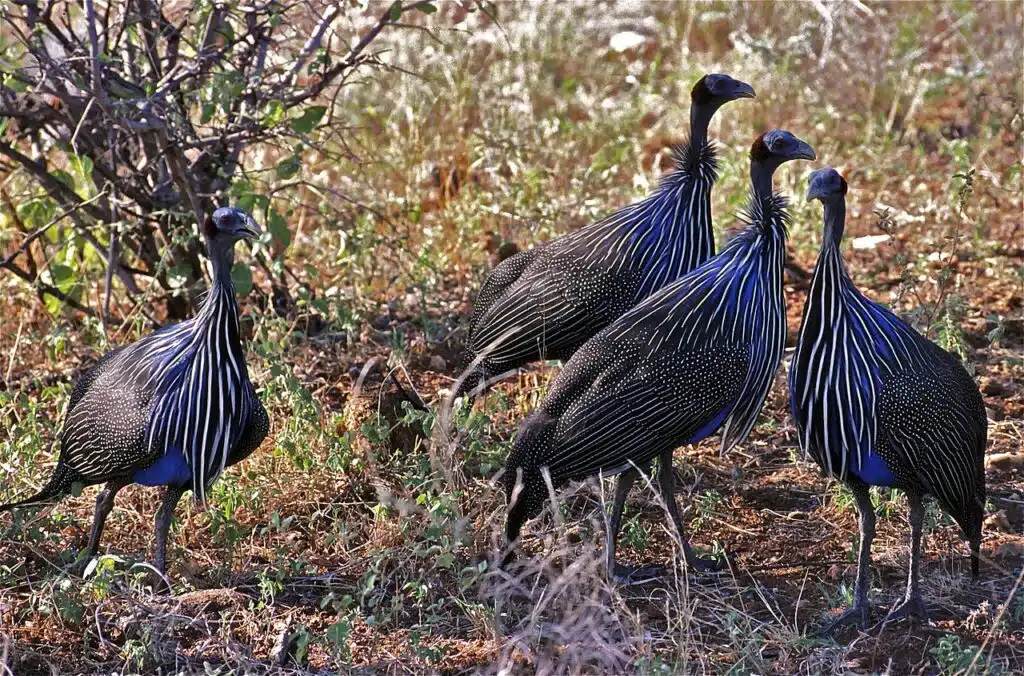
The Vulturine Guineafowl (Acryllium vulturinum) is a large bird that can grow to 71cm in length. They have round bodies with small heads. Their legs, neck, tail, and wings are longer than other guineafowls.
Adults have blue faces and black necks. Their slim necks project from a cape of blue and white hackles. Their breasts are blue and the rest of the body is black with white patches. They have short rounded wings and long tails.
Females are slightly smaller than males and they are similar in appearance. Juveniles are gray-brown with dull blue breasts.
Distribution: Ethiopia, Kenya, Somalia, and Tanzania
Migratory: No
40. Blue-and-black Tanager
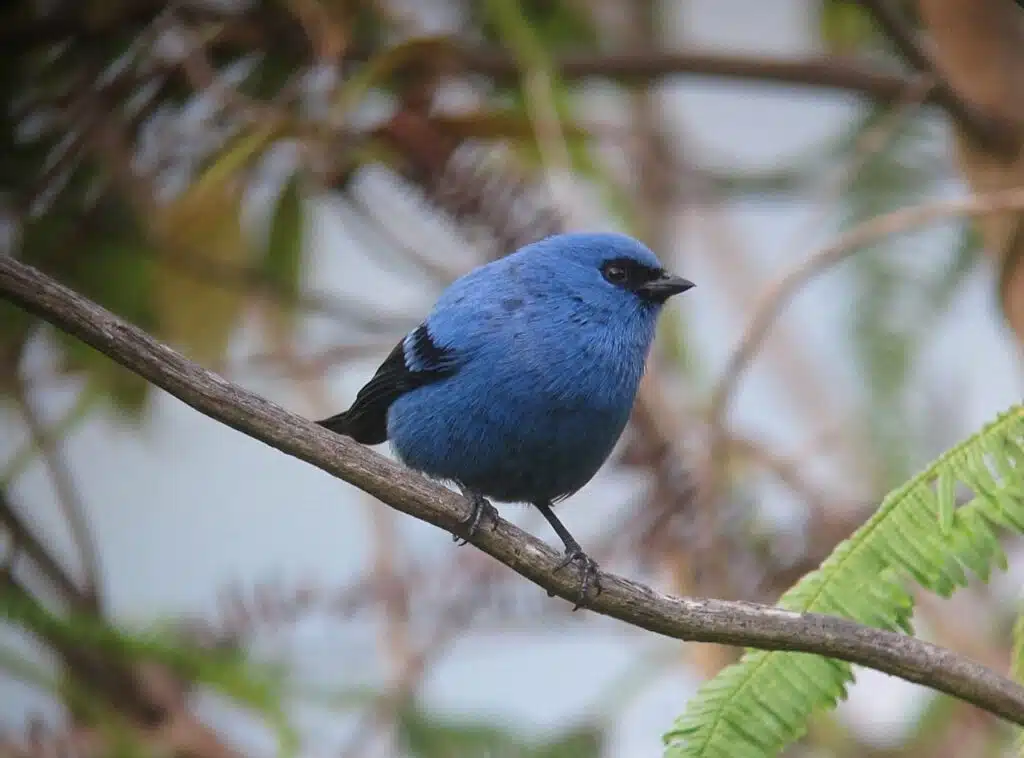
The Blue-and-black Tanager (Tangara vassorii) can be seen in evergreen forests, secondary forests, and dwarf forests. The sexes are similar in appearance with females not being as bright as the males.
They feed on arthropods and fruits. They can be seen foraging in flocks or pairs. These birds grow to around 13cm in length with a weight of 19g. Males are cobalt blue with a black mask. The tail feathers and wings are black with blue edges. Juveniles are gray with black wings, lores, and tails.
Distribution: Andes of Bolivia, Colombia, Ecuador, Peru, and Venezuela
Migratory: No
41. Blue-black Grassquit
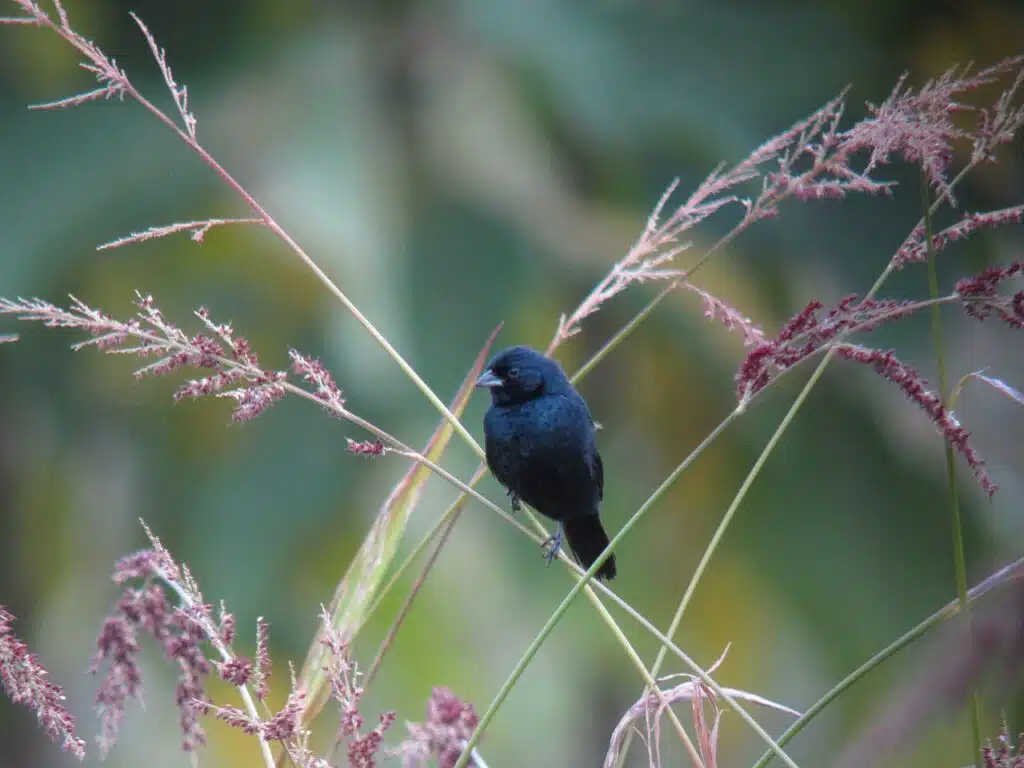
The Blue-black Grassquit (Volatinia jacarina) is a small bird and is sexually dimorphism. The males are glossy blue with white under the wing. Females, on the other hand, are brown on their backs and pale on their belly with dark streaks.
This bird can grow to 10.2cm in length and weigh just under 10g. They have slender bills.
Distribution: Mexico, Central America, Colombia, Venezuela, Amazon Basin, Trinidad and Tobago, and Grenada.
Migratory: No
42. Diademed Tanager
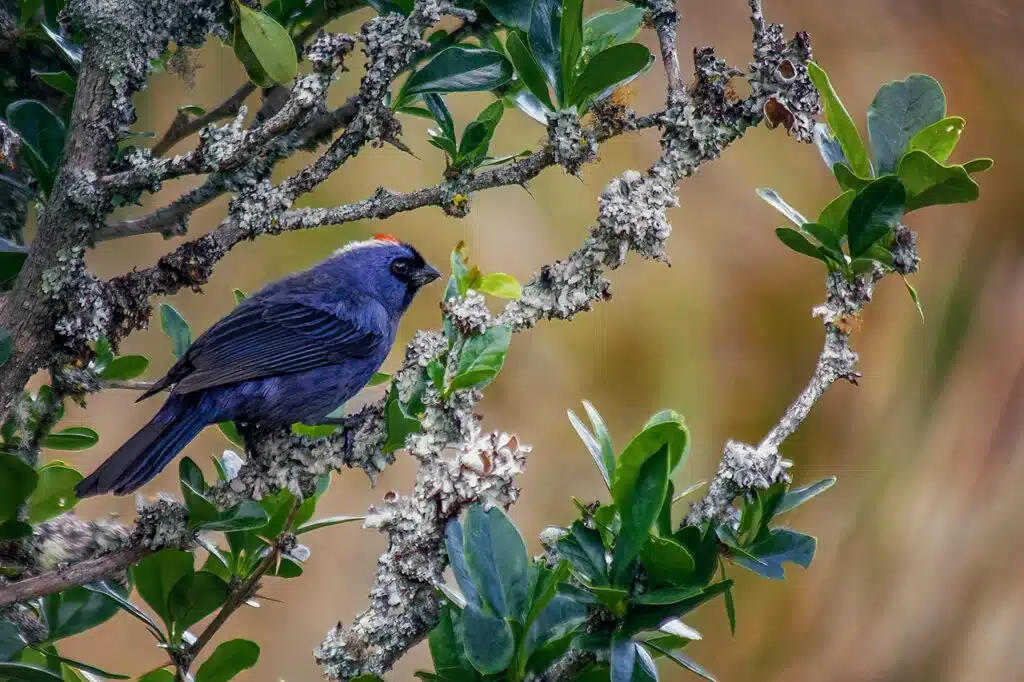
Diademed Tanager (Stephanophorus diadematus) is purple-blue with a white crown. They can grow to around 19cm and weigh up to 41g. They are robust birds and colorful in the right light.
They appear black with a pale crown patch and short bills.
Distribution: Southeastern Brazil, Uruguay, Argentina, and southeastern Paraguay.
Migratory: Possibly migratory in Uruguay and Argentina.
43. Blackish-blue Seedeater
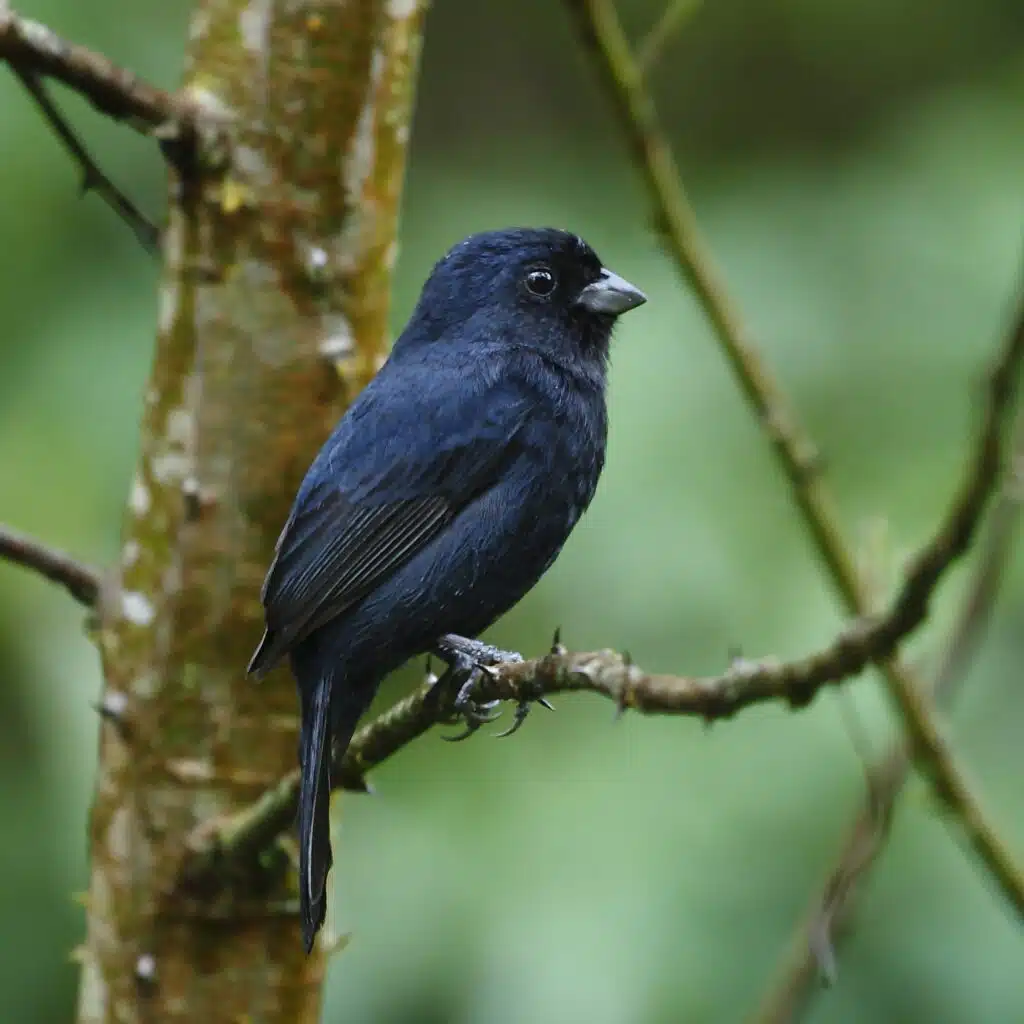
The Blackish-blue Seedeater (Amaurospiza moesta) can grow to 12.5cm in length and weigh up to 14g. Males are dark blue with darker blue faces and bellies. Females are brown with pale bellies.
These birds are found on woodland edges and in the undergrowth, in elevations that range from sea levels to 1,600m.
Distribution: Brazil, Paraguay, and Argentina.
Migratory: No
44. Blackish Rail
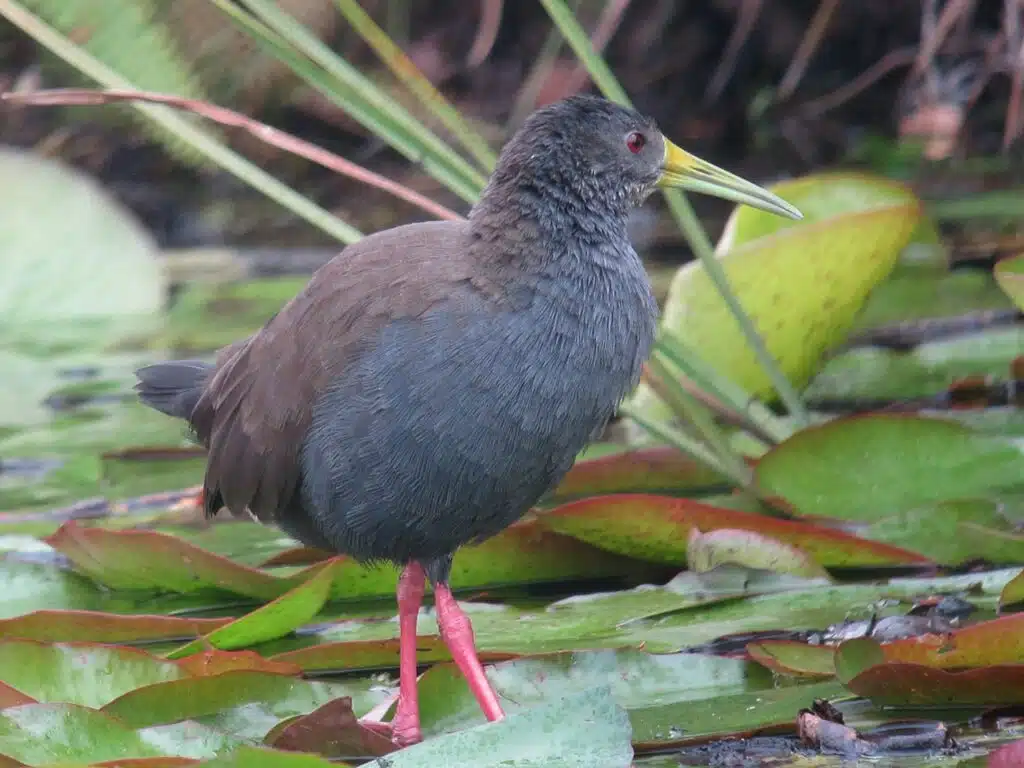
The Blackish Rail (Pardirallus nigricans) belongs to the coot family. They grow to 29cm in length and can weigh up to 2178g. The males and females are very similar with green-yellow bills and pink legs.
They are dark brown on their backs with white chins and throats. The face and belly are dark gray. They are medium-sized, plump, and chicken-like marsh birds found in wet landscapes, including heavily vegetated waterways, rice fields, lightly wooded swamps, marshes, and wet grasslands.
Distribution: Argentina, Brazil, Colombia, Ecuador, Paraguay, Peru, Venezuela, and Bolivia.
Migratory: No
45. Meves’s Starling
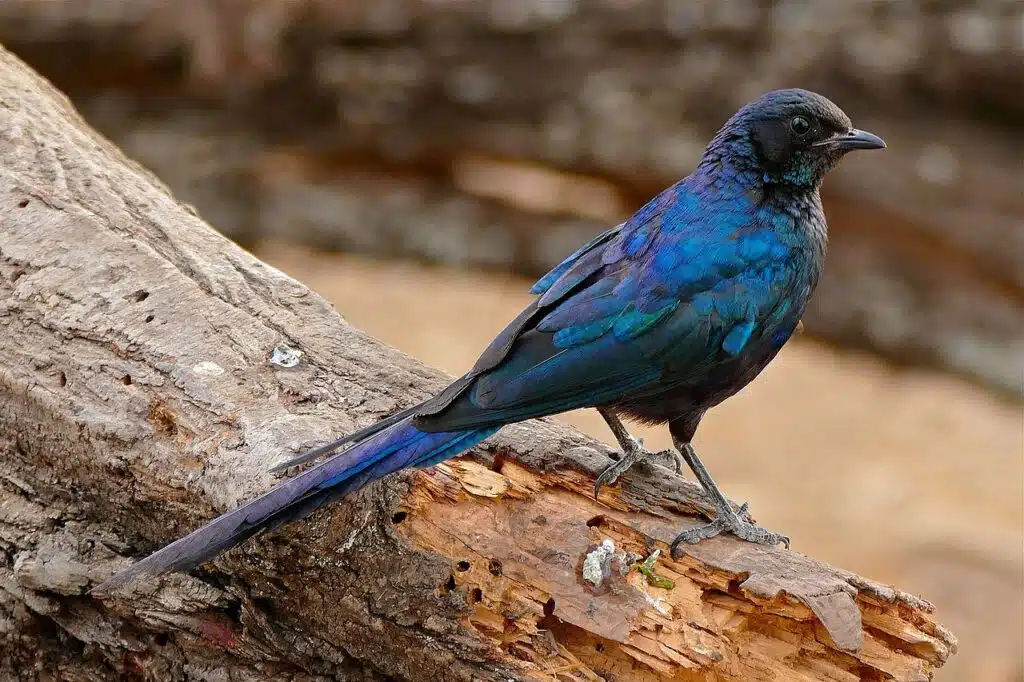
The Meves’s Starling (Lamprotornis mevesii) is a medium-sized bird with a long tail. They are iridescent blue and purple. They are seen in groups, flocks, and pairs in broadleaf woodlands and savannas. It is common to see them walking along on the ground or sitting in low trees as they search for insects to feed on.
They can grow to 30cm in length with a weight of 70g.
Distribution: Angola, Botswana, Malawi, Mozambique, Namibia, South Africa, Zambia, and Zimbabwe
Migratory: No
46. Square-tailed Drongo-Cuckoo
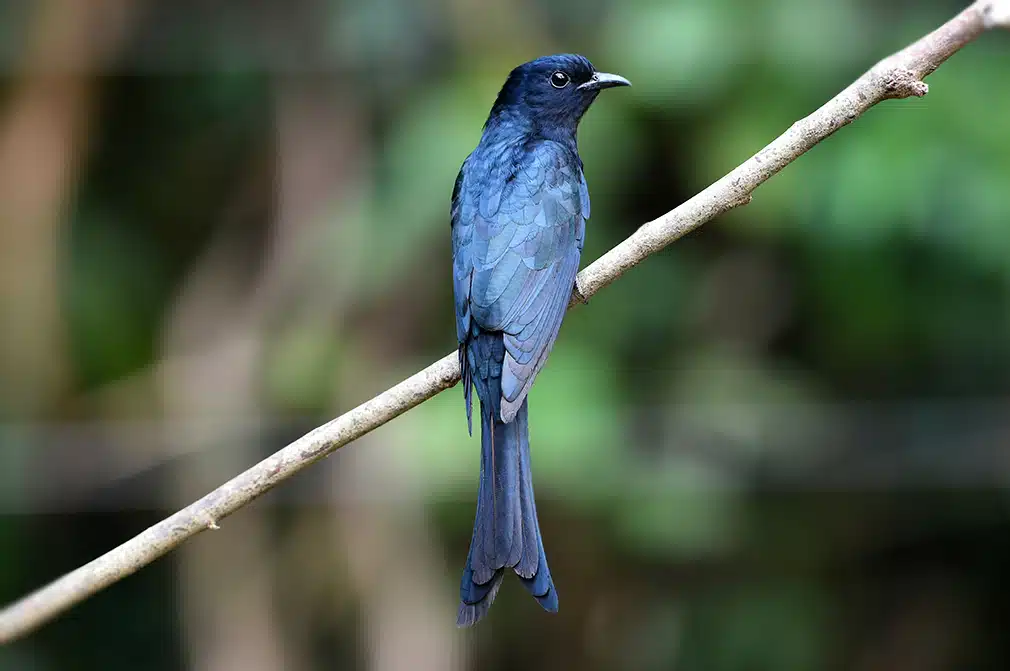
The Square-tailed Drongo-Cuckoo (Surniculus lugubris) is easily identified with its downcurved beak and white outer section under the tail. These birds have a white wing stripe when they fly, which is visible from below.
These birds can grow to 25cm in length and weigh up to 43.6g. They are slim and black with curved tails. Adults have white bars in the under tail section. They hide in vegetation on the edge of lowlands and foothill forests, making them difficult to see.
Distribution: Sri Lanka, Southeast Asia, Kashmir, and eastern Bangladesh.
Migratory: Yes